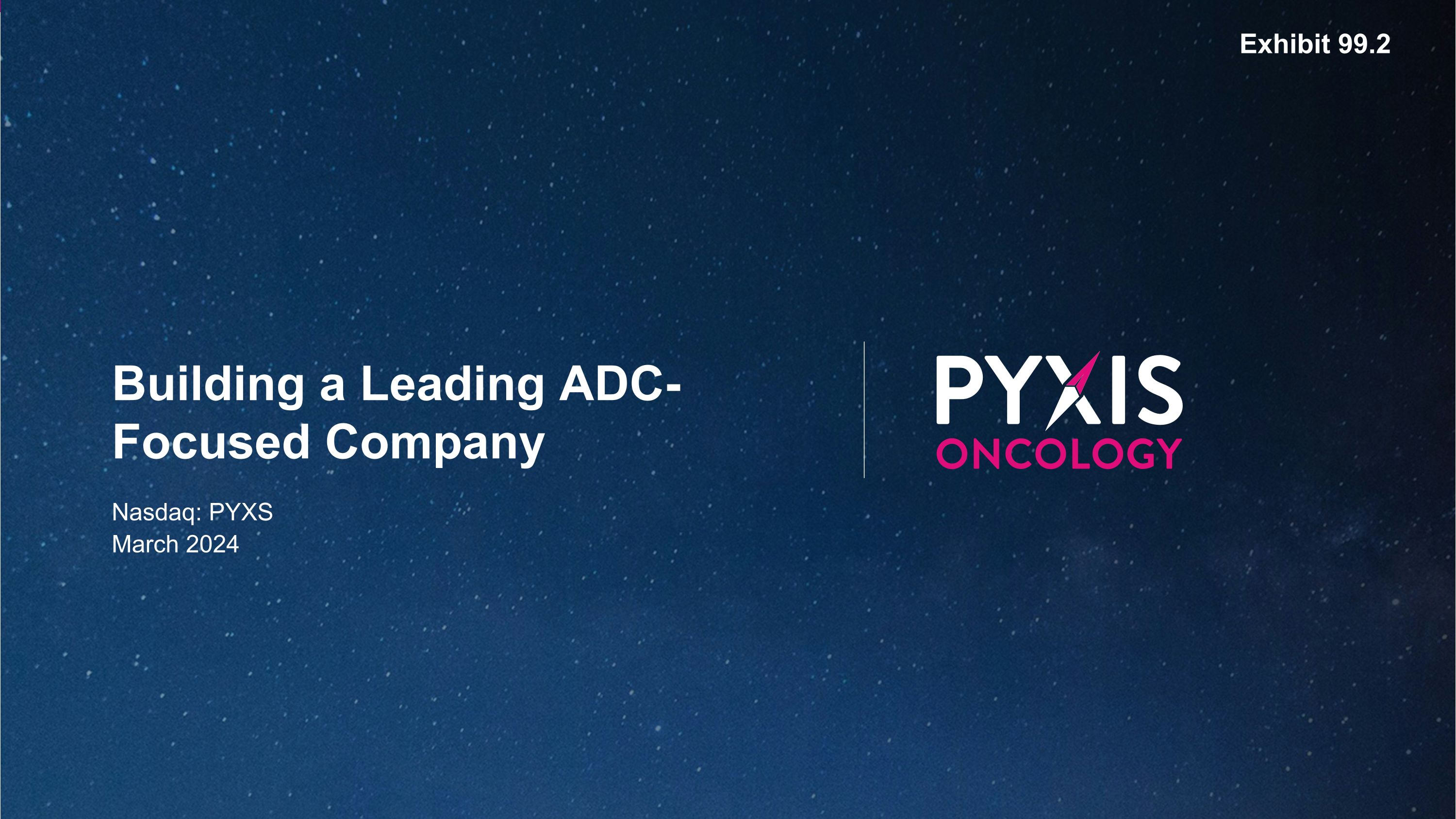
Building a Leading ADC-Focused Company Nasdaq: PYXS March 2024 Exhibit 99.2
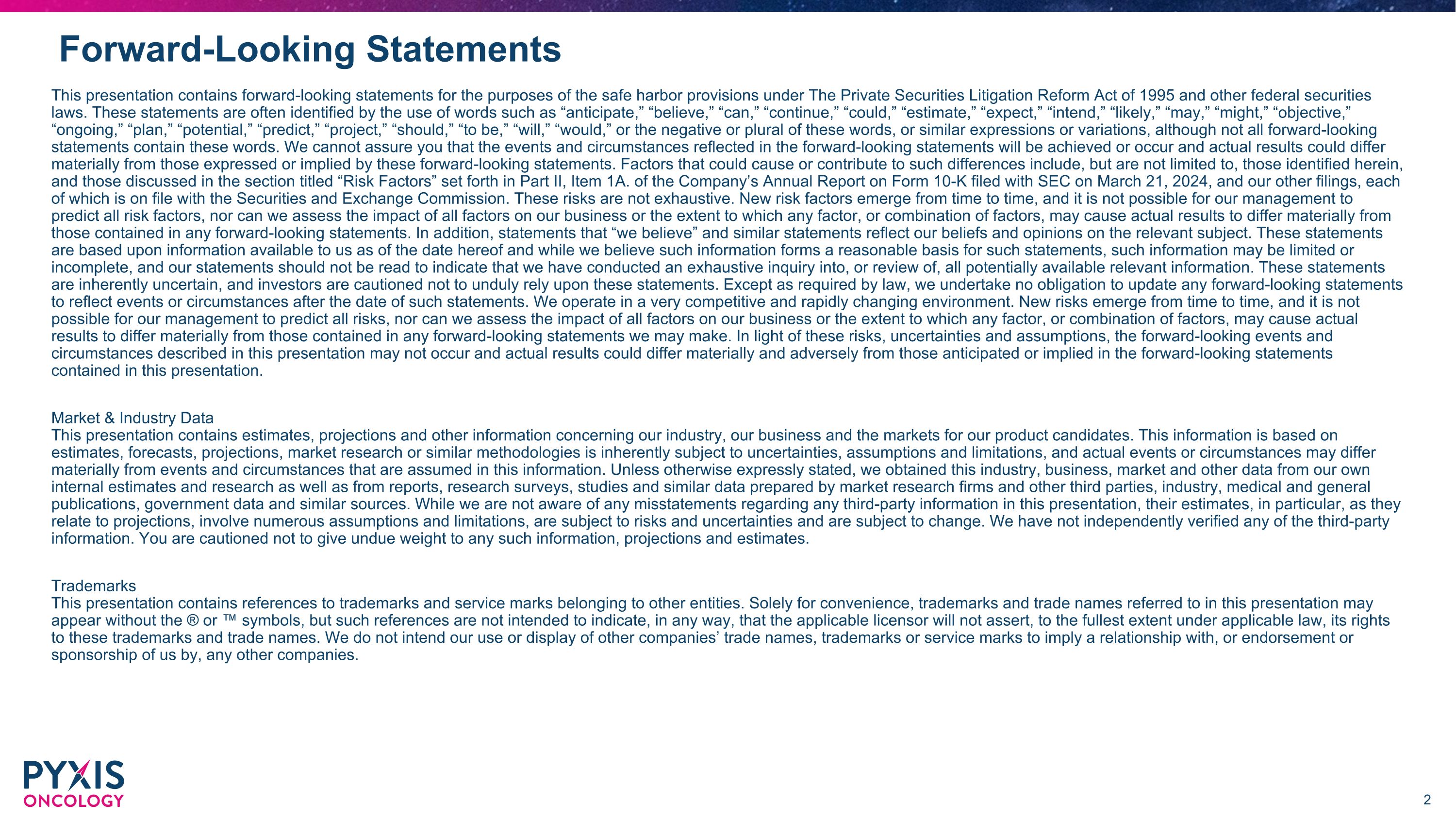
Forward-Looking Statements This presentation contains forward-looking statements for the purposes of the safe harbor provisions under The Private Securities Litigation Reform Act of 1995 and other federal securities laws. These statements are often identified by the use of words such as “anticipate,” “believe,” “can,” “continue,” “could,” “estimate,” “expect,” “intend,” “likely,” “may,” “might,” “objective,” “ongoing,” “plan,” “potential,” “predict,” “project,” “should,” “to be,” “will,” “would,” or the negative or plural of these words, or similar expressions or variations, although not all forward-looking statements contain these words. We cannot assure you that the events and circumstances reflected in the forward-looking statements will be achieved or occur and actual results could differ materially from those expressed or implied by these forward-looking statements. Factors that could cause or contribute to such differences include, but are not limited to, those identified herein, and those discussed in the section titled “Risk Factors” set forth in Part II, Item 1A. of the Company’s Annual Report on Form 10-K filed with SEC on March 21, 2024, and our other filings, each of which is on file with the Securities and Exchange Commission. These risks are not exhaustive. New risk factors emerge from time to time, and it is not possible for our management to predict all risk factors, nor can we assess the impact of all factors on our business or the extent to which any factor, or combination of factors, may cause actual results to differ materially from those contained in any forward-looking statements. In addition, statements that “we believe” and similar statements reflect our beliefs and opinions on the relevant subject. These statements are based upon information available to us as of the date hereof and while we believe such information forms a reasonable basis for such statements, such information may be limited or incomplete, and our statements should not be read to indicate that we have conducted an exhaustive inquiry into, or review of, all potentially available relevant information. These statements are inherently uncertain, and investors are cautioned not to unduly rely upon these statements. Except as required by law, we undertake no obligation to update any forward-looking statements to reflect events or circumstances after the date of such statements. We operate in a very competitive and rapidly changing environment. New risks emerge from time to time, and it is not possible for our management to predict all risks, nor can we assess the impact of all factors on our business or the extent to which any factor, or combination of factors, may cause actual results to differ materially from those contained in any forward-looking statements we may make. In light of these risks, uncertainties and assumptions, the forward-looking events and circumstances described in this presentation may not occur and actual results could differ materially and adversely from those anticipated or implied in the forward-looking statements contained in this presentation. Market & Industry Data�This presentation contains estimates, projections and other information concerning our industry, our business and the markets for our product candidates. This information is based on estimates, forecasts, projections, market research or similar methodologies is inherently subject to uncertainties, assumptions and limitations, and actual events or circumstances may differ materially from events and circumstances that are assumed in this information. Unless otherwise expressly stated, we obtained this industry, business, market and other data from our own internal estimates and research as well as from reports, research surveys, studies and similar data prepared by market research firms and other third parties, industry, medical and general publications, government data and similar sources. While we are not aware of any misstatements regarding any third-party information in this presentation, their estimates, in particular, as they relate to projections, involve numerous assumptions and limitations, are subject to risks and uncertainties and are subject to change. We have not independently verified any of the third-party information. You are cautioned not to give undue weight to any such information, projections and estimates. Trademarks�This presentation contains references to trademarks and service marks belonging to other entities. Solely for convenience, trademarks and trade names referred to in this presentation may appear without the ® or ™ symbols, but such references are not intended to indicate, in any way, that the applicable licensor will not assert, to the fullest extent under applicable law, its rights to these trademarks and trade names. We do not intend our use or display of other companies’ trade names, trademarks or service marks to imply a relationship with, or endorsement or sponsorship of us by, any other companies.
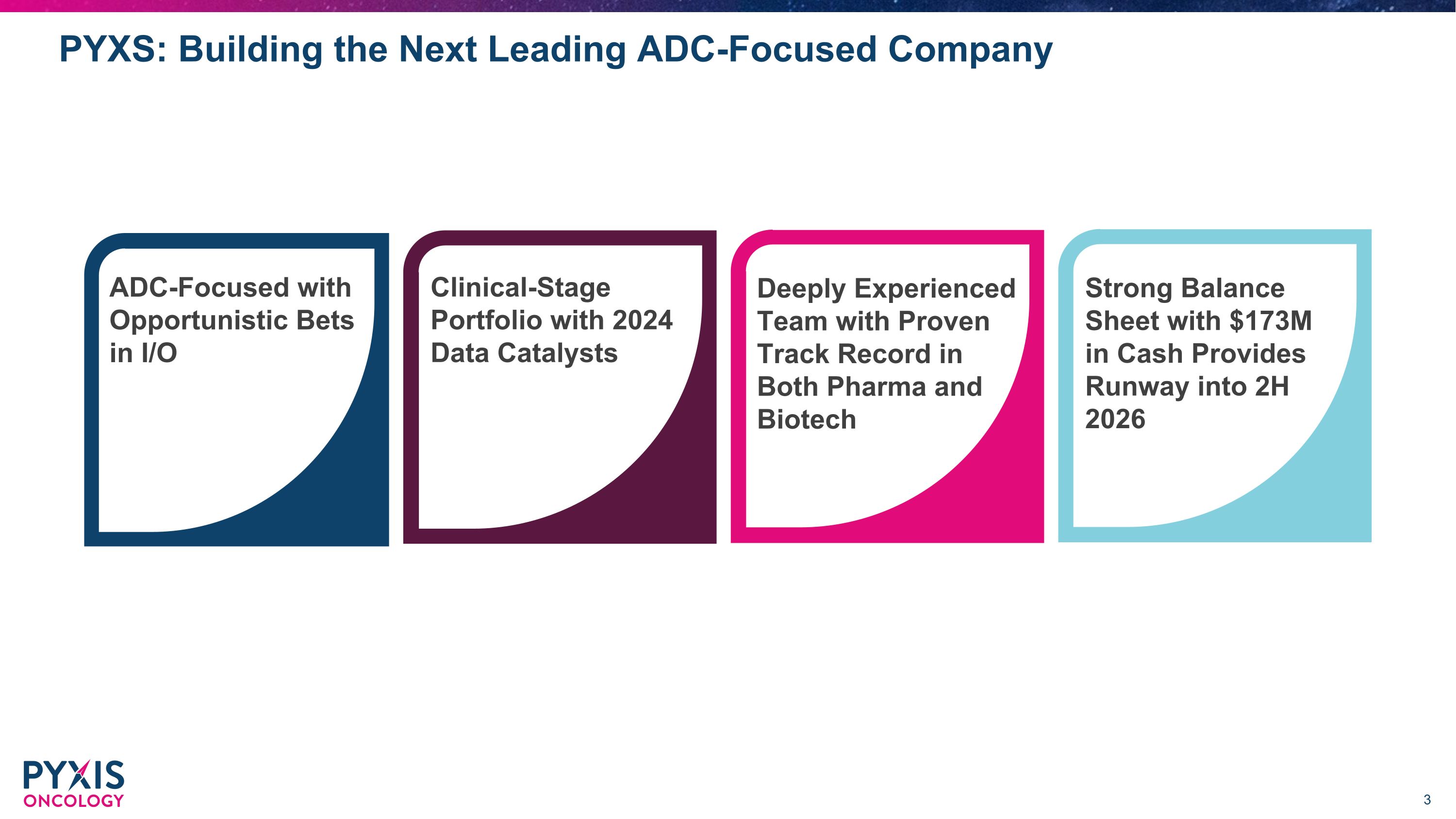
PYXS: Building the Next Leading ADC-Focused Company ADC-Focused with Opportunistic Bets in I/O Deeply Experienced Team with Proven Track Record in Both Pharma and Biotech Clinical-Stage Portfolio with 2024 Data Catalysts Strong Balance Sheet with $173M in Cash Provides Runway into 2H 2026
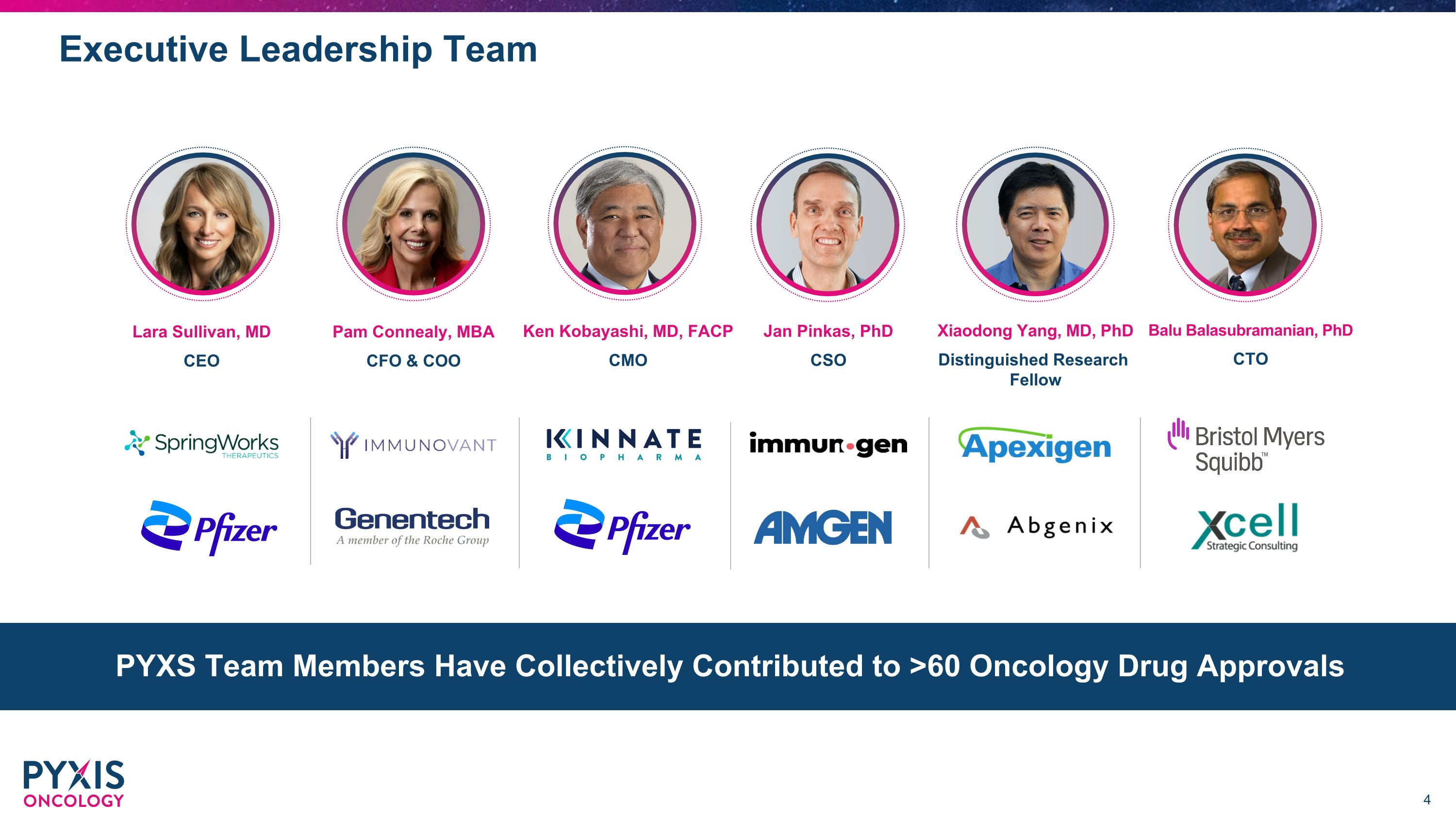
Lara Sullivan, MD CEO Xiaodong Yang, MD, PhD Distinguished Research Fellow Jan Pinkas, PhD CSO Pam Connealy, MBA CFO & COO Balu Balasubramanian, PhD CTO Executive Leadership Team PYXS Team Members Have Collectively Contributed to >60 Oncology Drug Approvals Ken Kobayashi, MD, FACP CMO
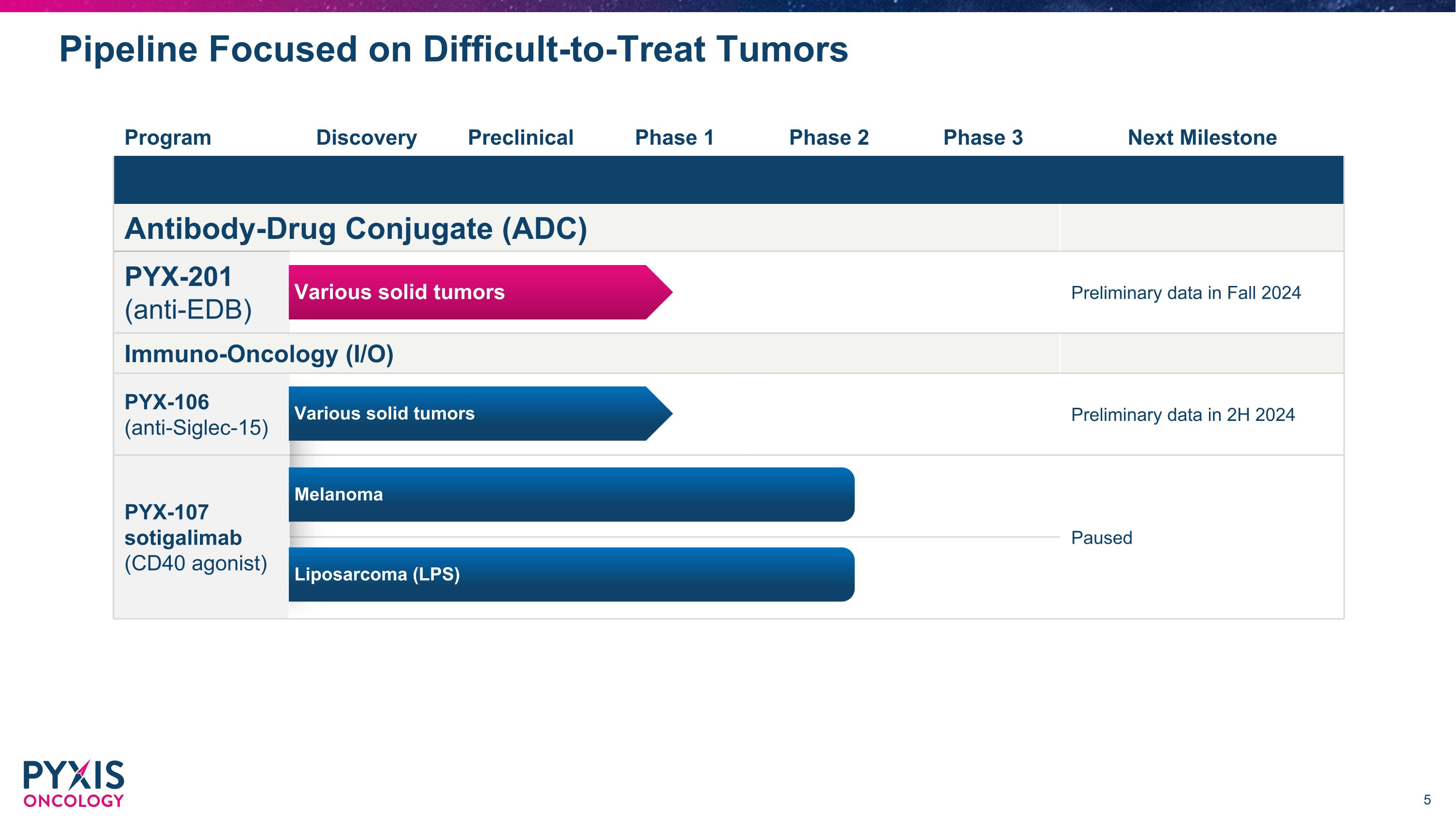
Pipeline Focused on Difficult-to-Treat Tumors Program Discovery Preclinical Phase 1 Phase 2 Phase 3 Next Milestone Antibody-Drug Conjugate (ADC) PYX-201 (anti-EDB) Preliminary data in Fall 2024 Immuno-Oncology (I/O) PYX-106 (anti-Siglec-15) Preliminary data in 2H 2024 PYX-107 sotigalimab (CD40 agonist) Paused Liposarcoma (LPS) Various solid tumors Melanoma Various solid tumors
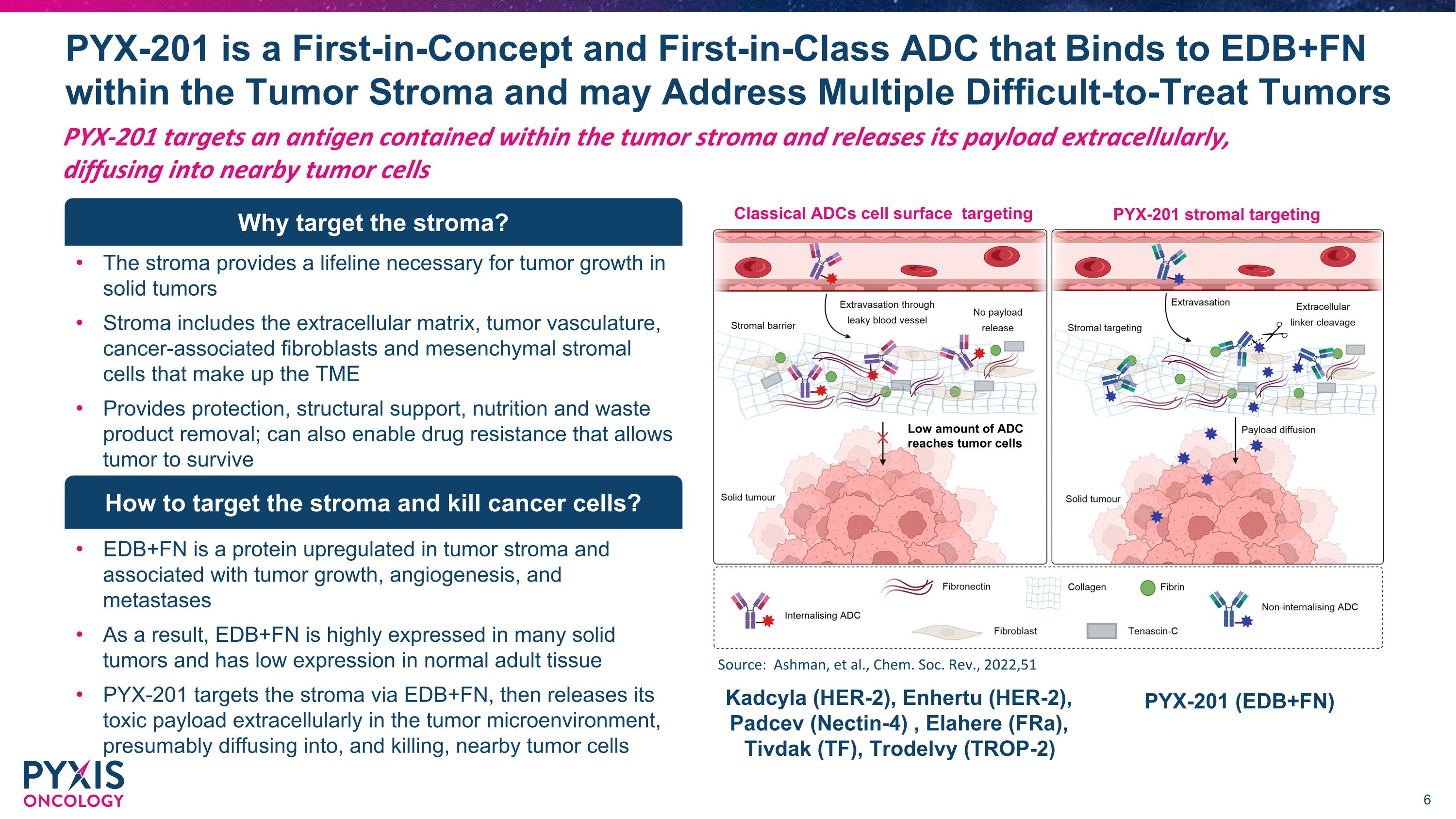
PYX-201 targets an antigen contained within the tumor stroma and releases its payload extracellularly, diffusing into nearby tumor cells PYX-201 is a First-in-Concept and First-in-Class ADC that Binds to EDB+FN within the Tumor Stroma and may Address Multiple Difficult-to-Treat Tumors The stroma provides a lifeline necessary for tumor growth in solid tumors Stroma includes the extracellular matrix, tumor vasculature, cancer-associated fibroblasts and mesenchymal stromal cells that make up the TME Provides protection, structural support, nutrition and waste product removal; can also enable drug resistance that allows tumor to survive Why target the stroma? EDB+FN is a protein upregulated in tumor stroma and associated with tumor growth, angiogenesis, and metastases As a result, EDB+FN is highly expressed in many solid tumors and has low expression in normal adult tissue PYX-201 targets the stroma via EDB+FN, then releases its toxic payload extracellularly in the tumor microenvironment, presumably diffusing into, and killing, nearby tumor cells How to target the stroma and kill cancer cells? Classical ADCs cell surface targeting PYX-201 stromal targeting Low amount of ADC reaches tumor cells Source: Ashman, et al., Chem. Soc. Rev., 2022,51 Kadcyla (HER-2), Enhertu (HER-2), Padcev (Nectin-4) , Elahere (FRa), Tivdak (TF), Trodelvy (TROP-2) PYX-201 (EDB+FN)
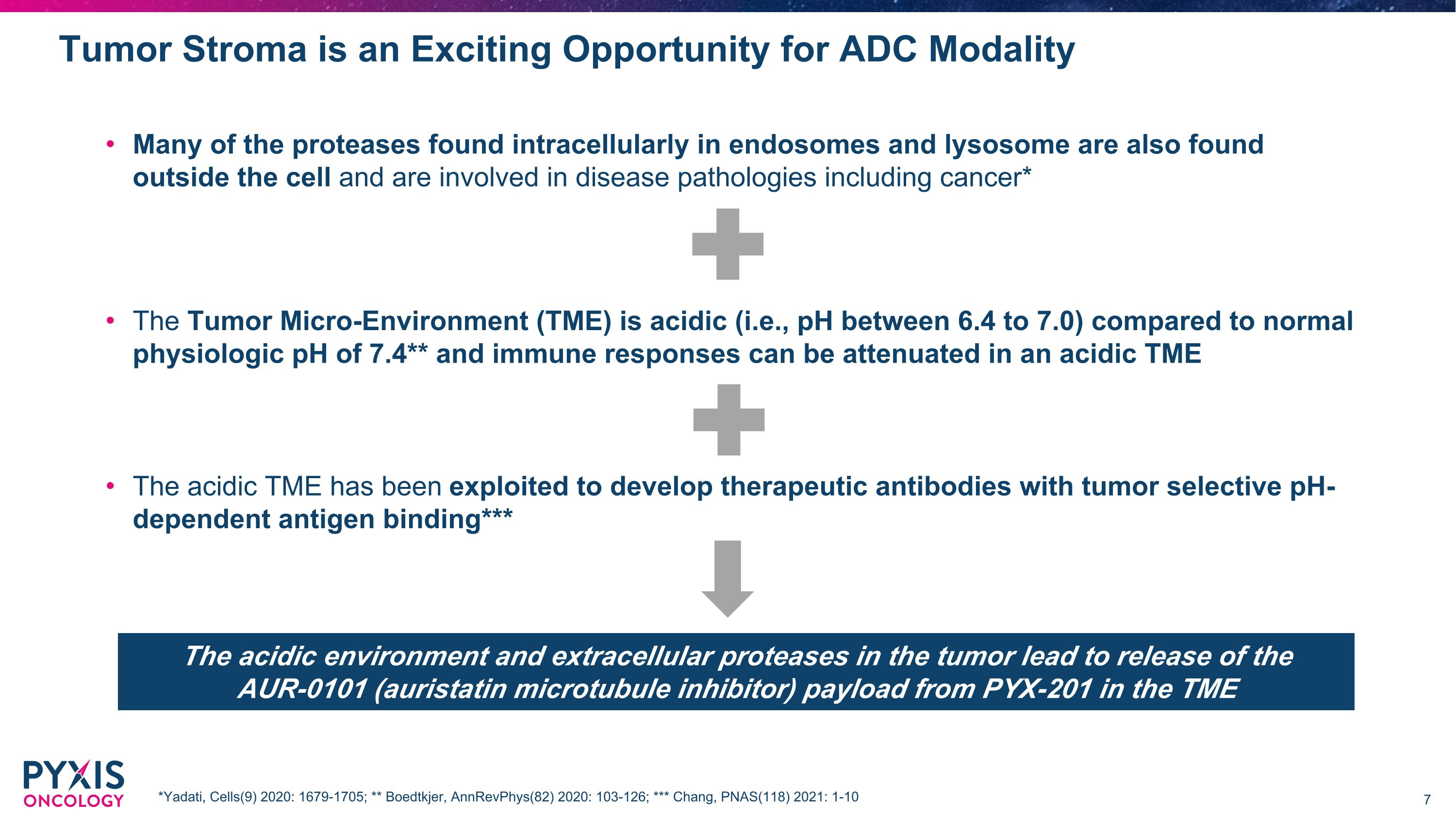
Tumor Stroma is an Exciting Opportunity for ADC Modality Many of the proteases found intracellularly in endosomes and lysosome are also found outside the cell and are involved in disease pathologies including cancer* The Tumor Micro-Environment (TME) is acidic (i.e., pH between 6.4 to 7.0) compared to normal physiologic pH of 7.4** and immune responses can be attenuated in an acidic TME The acidic TME has been exploited to develop therapeutic antibodies with tumor selective pH-dependent antigen binding*** *Yadati, Cells(9) 2020: 1679-1705; ** Boedtkjer, AnnRevPhys(82) 2020: 103-126; *** Chang, PNAS(118) 2021: 1-10 The acidic environment and extracellular proteases in the tumor lead to release of the AUR-0101 (auristatin microtubule inhibitor) payload from PYX-201 in the TME
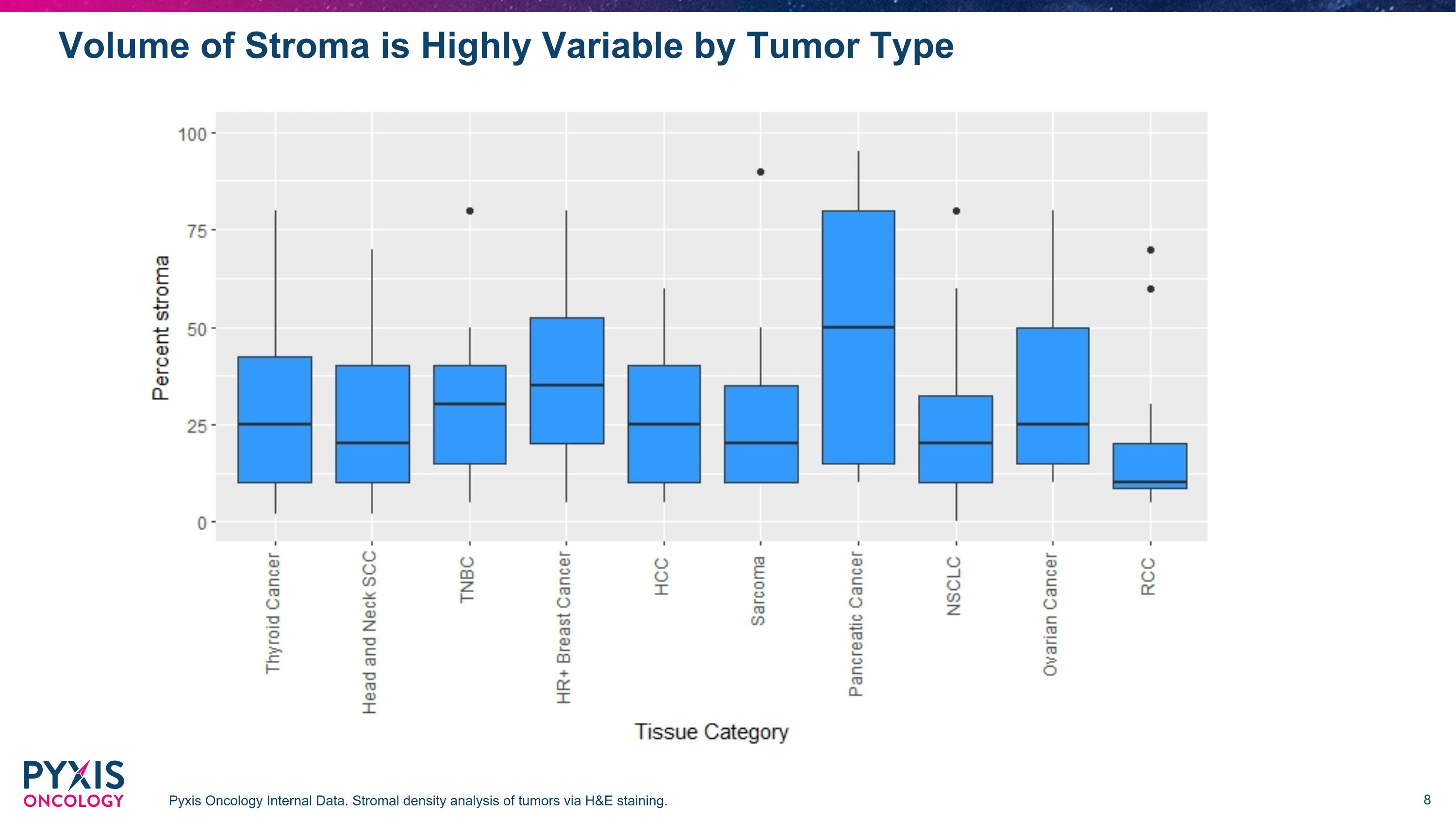
Volume of Stroma is Highly Variable by Tumor Type Pyxis Oncology Internal Data. Stromal density analysis of tumors via H&E staining.
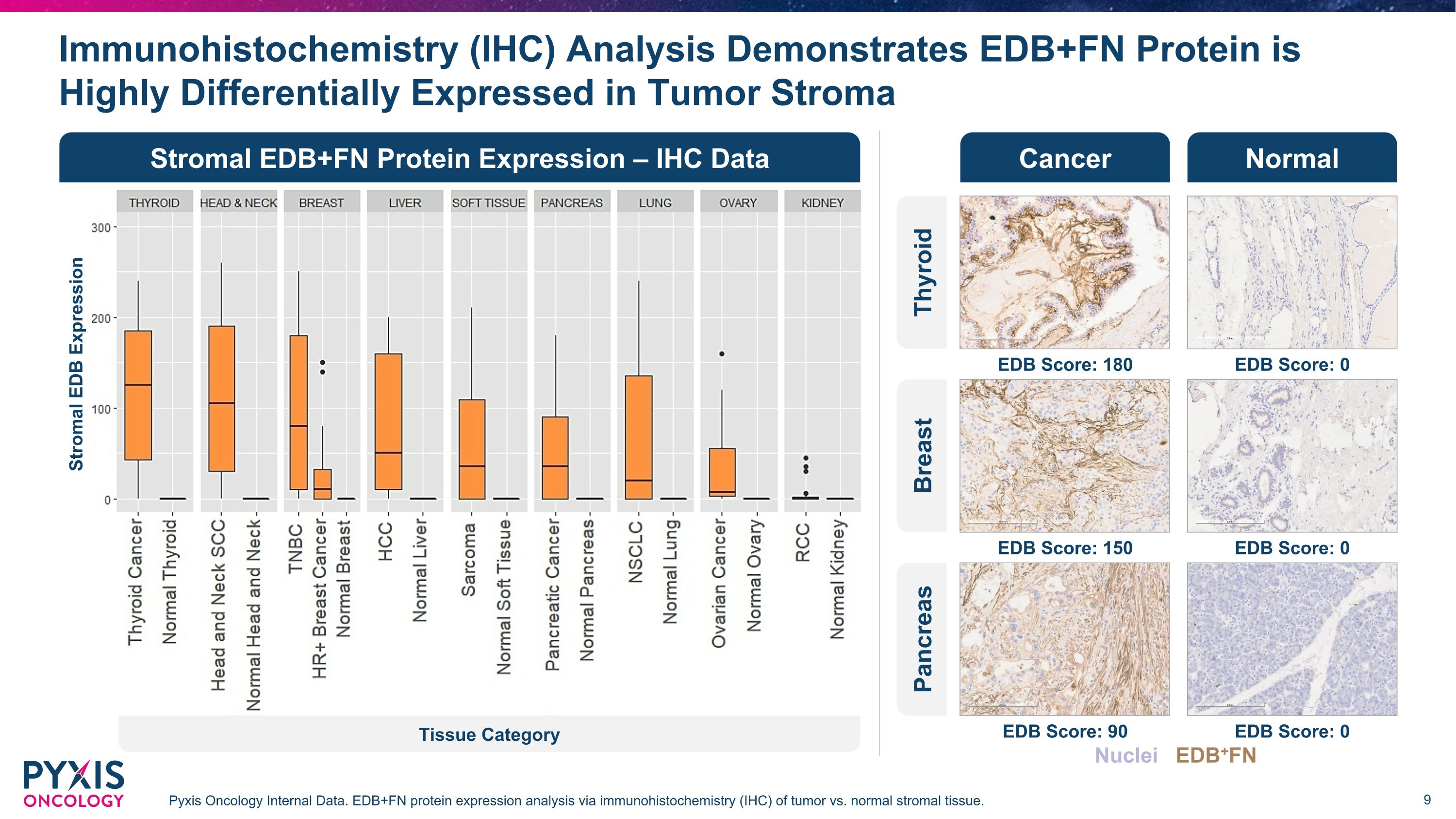
Immunohistochemistry (IHC) Analysis Demonstrates EDB+FN Protein is Highly Differentially Expressed in Tumor Stroma Pyxis Oncology Internal Data. EDB+FN protein expression analysis via immunohistochemistry (IHC) of tumor vs. normal stromal tissue. Stromal EDB+FN Protein Expression – IHC Data Normal Cancer Thyroid EDB Score: 180 EDB Score: 0 Breast EDB Score: 150 EDB Score: 0 Pancreas EDB Score: 90 EDB Score: 0 Stromal EDB Expression Tissue Category Nuclei EDB+FN
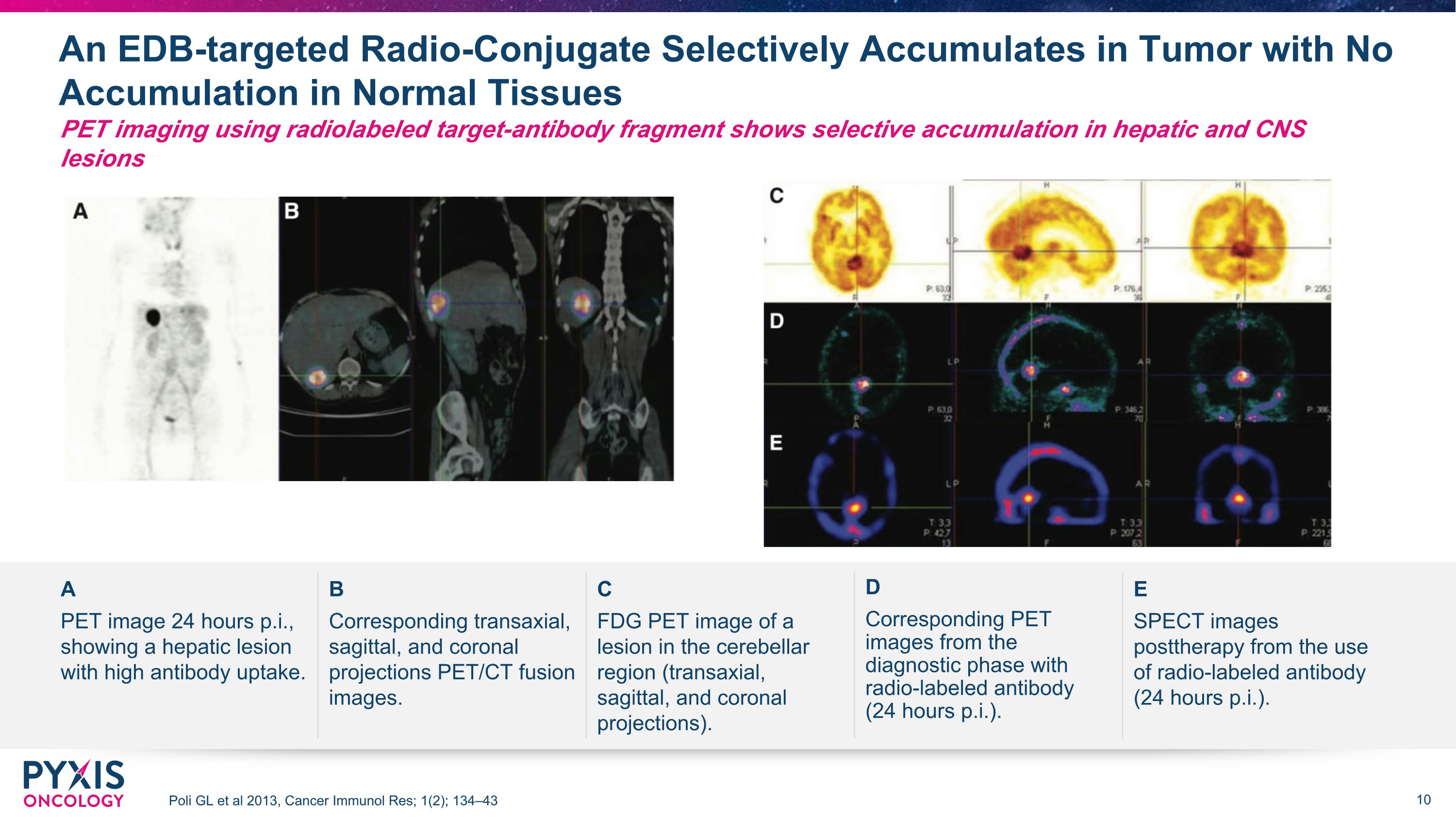
An EDB-targeted Radio-Conjugate Selectively Accumulates in Tumor with No Accumulation in Normal Tissues Poli GL et al 2013, Cancer Immunol Res; 1(2); 134–43 PET imaging using radiolabeled target-antibody fragment shows selective accumulation in hepatic and CNS lesions A B C D E PET image 24 hours p.i., showing a hepatic lesion with high antibody uptake. Corresponding transaxial, sagittal, and coronal projections PET/CT fusion images. FDG PET image of a lesion in the cerebellar region (transaxial, sagittal, and coronal projections). Corresponding PET images from the diagnostic phase with radio-labeled antibody �(24 hours p.i.). SPECT images posttherapy from the use of radio-labeled antibody (24 hours p.i.).
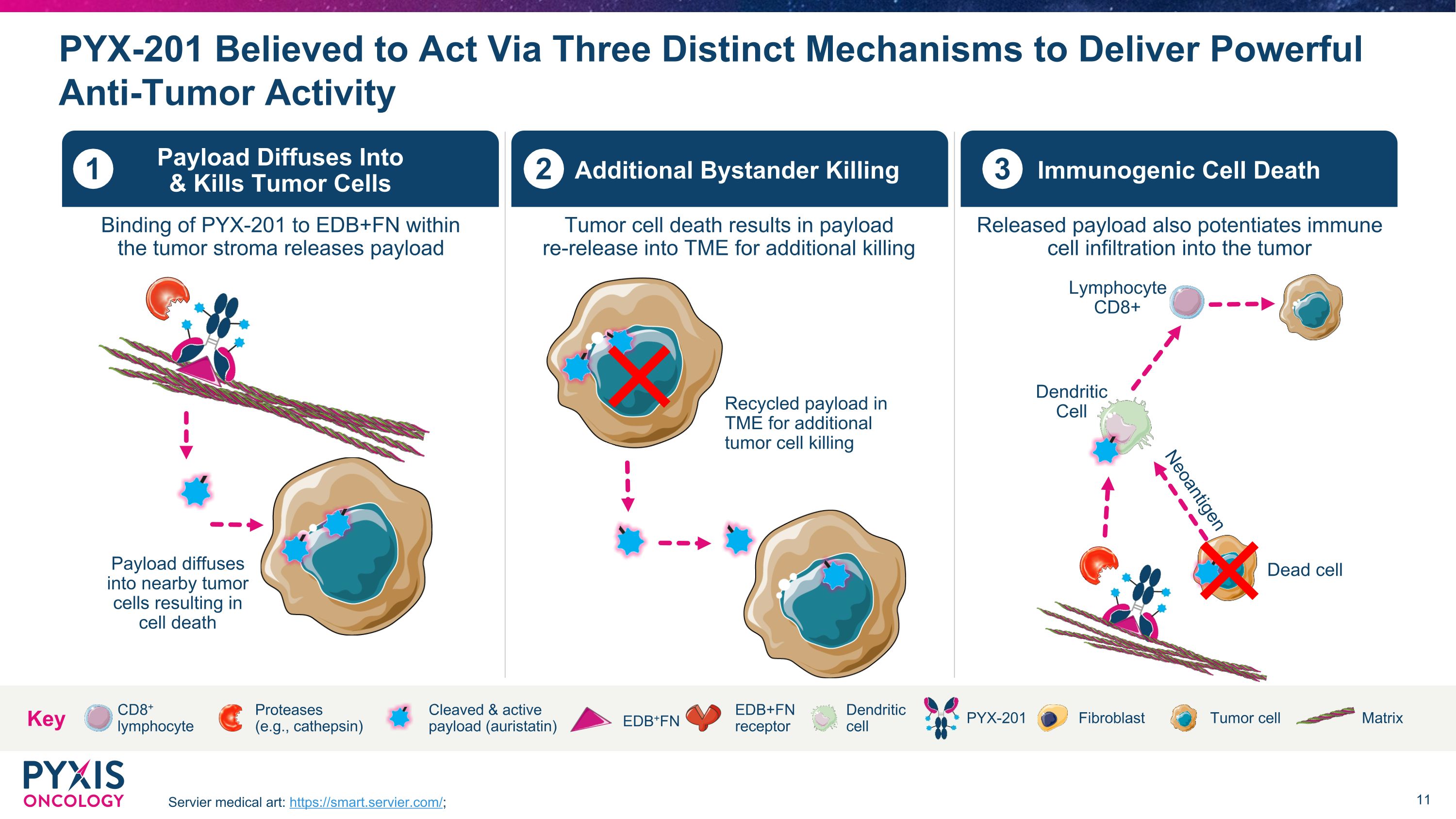
PYX-201 Believed to Act Via Three Distinct Mechanisms to Deliver Powerful �Anti-Tumor Activity Servier medical art: https://smart.servier.com/; CD8+ lymphocyte Dendritic �cell PYX-201 Cleaved & active payload (auristatin) Tumor cell Fibroblast EDB+FN Matrix EDB+FN �receptor Proteases (e.g., cathepsin) Key Additional Bystander Killing 2 Tumor cell death results in payload �re-release into TME for additional killing Payload Diffuses Into �& Kills Tumor Cells 1 Binding of PYX-201 to EDB+FN within �the tumor stroma releases payload Immunogenic Cell Death 3 Released payload also potentiates immune cell infiltration into the tumor Payload diffuses into nearby tumor cells resulting in cell death Recycled payload in TME for additional tumor cell killing Dendritic Cell Lymphocyte CD8+ Dead cell Neoantigen
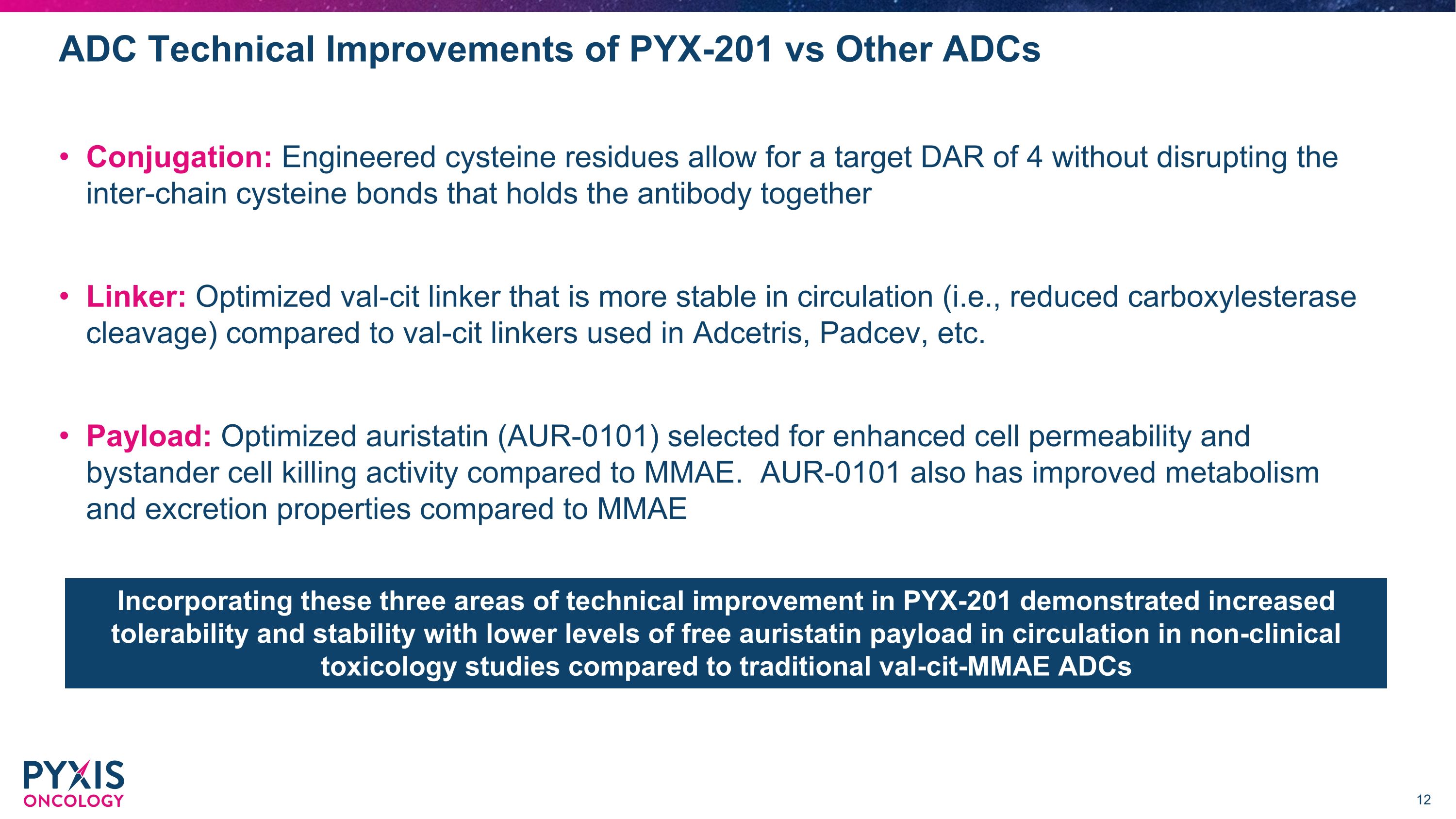
ADC Technical Improvements of PYX-201 vs Other ADCs Conjugation: Engineered cysteine residues allow for a target DAR of 4 without disrupting the inter-chain cysteine bonds that holds the antibody together Linker: Optimized val-cit linker that is more stable in circulation (i.e., reduced carboxylesterase cleavage) compared to val-cit linkers used in Adcetris, Padcev, etc. Payload: Optimized auristatin (AUR-0101) selected for enhanced cell permeability and bystander cell killing activity compared to MMAE. AUR-0101 also has improved metabolism and excretion properties compared to MMAE Incorporating these three areas of technical improvement in PYX-201 demonstrated increased tolerability and stability with lower levels of free auristatin payload in circulation in non-clinical toxicology studies compared to traditional val-cit-MMAE ADCs
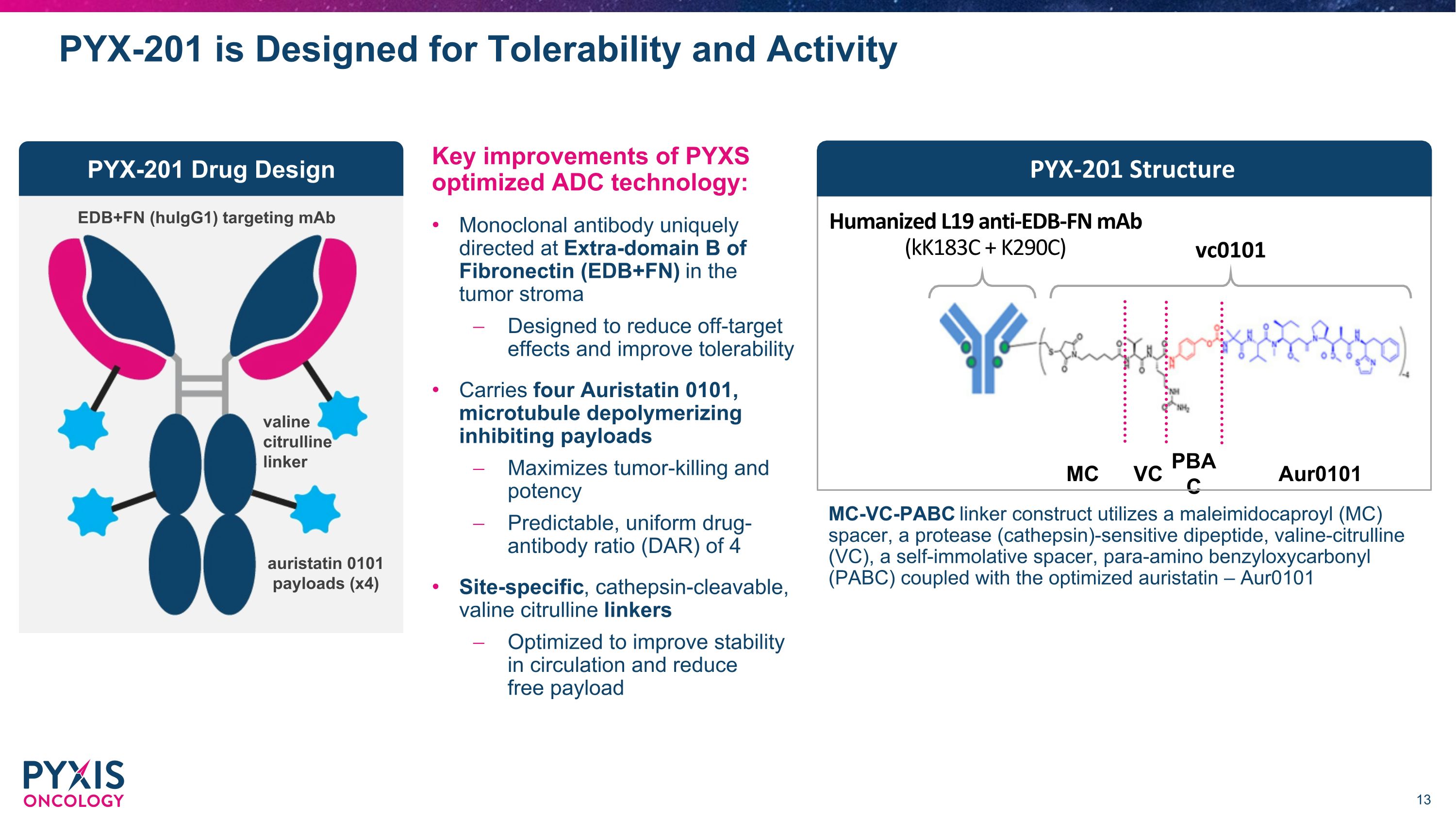
PYX-201 is Designed for Tolerability and Activity Key improvements of PYXS optimized ADC technology: Monoclonal antibody uniquely directed at Extra-domain B of Fibronectin (EDB+FN) in the tumor stroma Designed to reduce off-target effects and improve tolerability Carries four Auristatin 0101, microtubule depolymerizing inhibiting payloads Maximizes tumor-killing and potency Predictable, uniform drug-antibody ratio (DAR) of 4 Site-specific, cathepsin-cleavable, valine citrulline linkers Optimized to improve stability in circulation and reduce �free payload EDB+FN (huIgG1) targeting mAb auristatin 0101 payloads (x4) valine citrulline linker PYX-201 Drug Design MC VC PBAC Aur0101 PYX-201 Structure Humanized L19 anti-EDB-FN mAb�(kK183C + K290C) vc0101 MC-VC-PABC linker construct utilizes a maleimidocaproyl (MC) spacer, a protease (cathepsin)-sensitive dipeptide, valine-citrulline (VC), a self-immolative spacer, para-amino benzyloxycarbonyl (PABC) coupled with the optimized auristatin – Aur0101
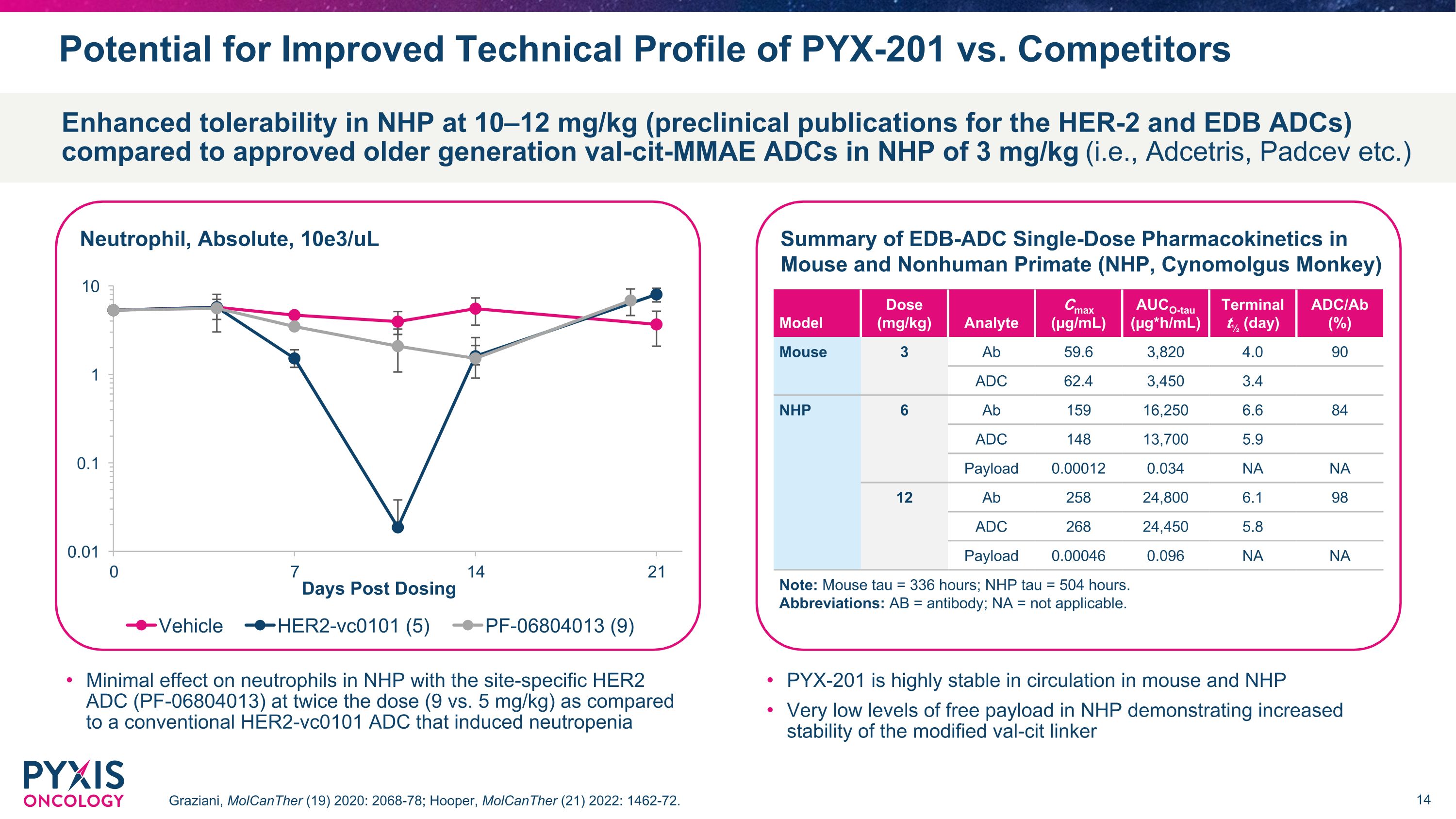
Potential for Improved Technical Profile of PYX-201 vs. Competitors Graziani, MolCanTher (19) 2020: 2068-78; Hooper, MolCanTher (21) 2022: 1462-72. Enhanced tolerability in NHP at 10–12 mg/kg (preclinical publications for the HER-2 and EDB ADCs) �compared to approved older generation val-cit-MMAE ADCs in NHP of 3 mg/kg (i.e., Adcetris, Padcev etc.) Minimal effect on neutrophils in NHP with the site-specific HER2 ADC (PF-06804013) at twice the dose (9 vs. 5 mg/kg) as compared to a conventional HER2-vc0101 ADC that induced neutropenia PYX-201 is highly stable in circulation in mouse and NHP Very low levels of free payload in NHP demonstrating increased stability of the modified val-cit linker Summary of EDB-ADC Single-Dose Pharmacokinetics in Mouse and Nonhuman Primate (NHP, Cynomolgus Monkey) Model Dose�(mg/kg) Analyte Cmax�(µg/mL) AUCO-tau�(µg*h/mL) Terminal�t½ (day) ADC/Ab (%) Mouse 3 Ab 59.6 3,820 4.0 90 ADC 62.4 3,450 3.4 NHP 6 Ab 159 16,250 6.6 84 ADC 148 13,700 5.9 Payload 0.00012 0.034 NA NA 12 Ab 258 24,800 6.1 98 ADC 268 24,450 5.8 Payload 0.00046 0.096 NA NA Note: Mouse tau = 336 hours; NHP tau = 504 hours. Abbreviations: AB = antibody; NA = not applicable. Neutrophil, Absolute, 10e3/uL
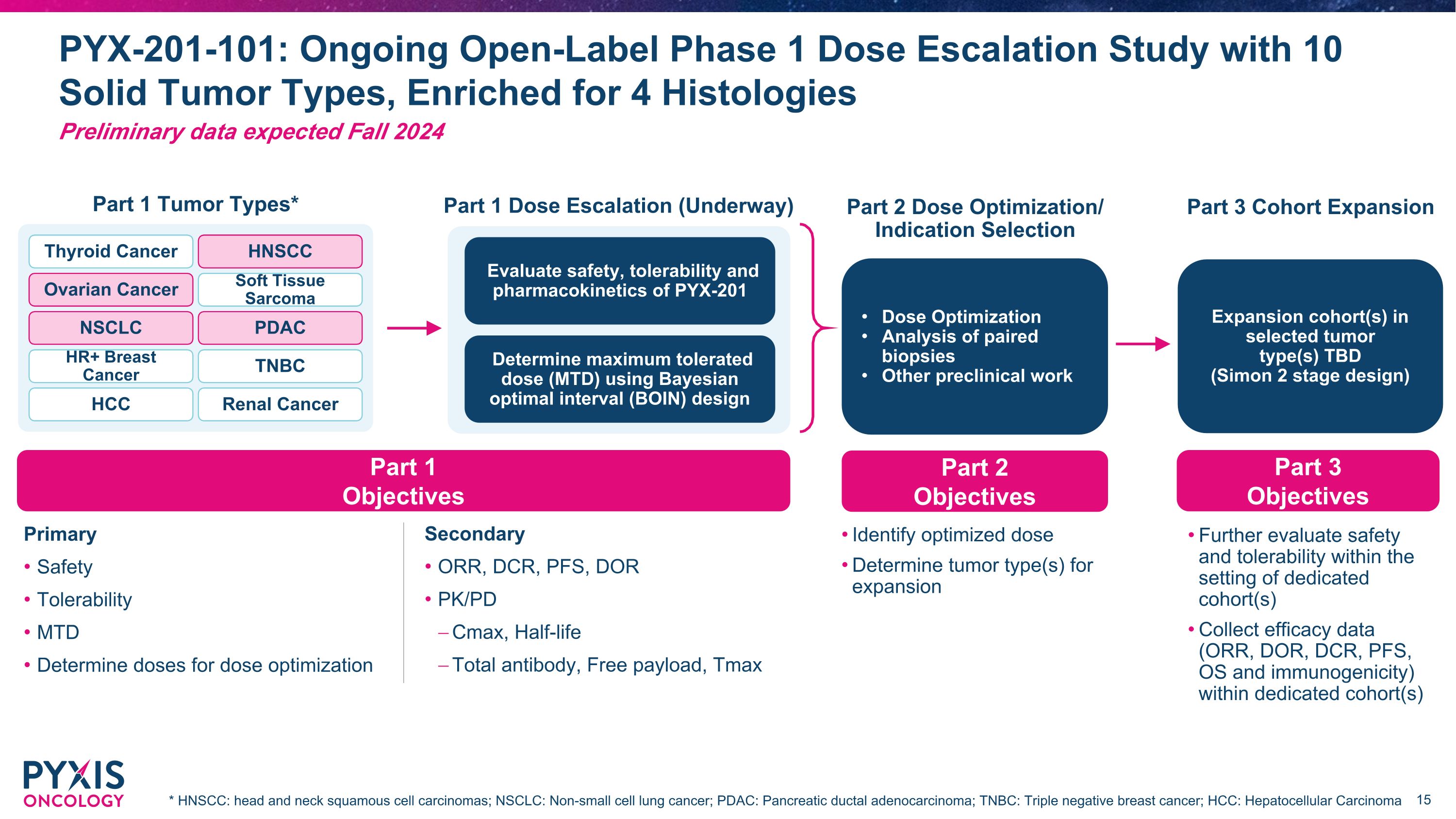
2022 1Q 2023 2024 PYX-201-101: Ongoing Open-Label Phase 1 Dose Escalation Study with 10 Solid Tumor Types, Enriched for 4 Histologies Preliminary data expected Fall 2024 Part 1 Tumor Types* Part 1 Dose Escalation (Underway) Part 2 Dose Optimization/ Indication Selection Expansion cohort(s) in selected tumor type(s) TBD (Simon 2 stage design) Dose Optimization Analysis of paired biopsies Other preclinical work Determine maximum tolerated dose (MTD) using Bayesian optimal interval (BOIN) design Evaluate safety, tolerability and pharmacokinetics of PYX-201 Ovarian Cancer NSCLC HR+ Breast Cancer HCC Soft Tissue Sarcoma PDAC TNBC Thyroid Cancer HNSCC Renal Cancer Part 3 Cohort Expansion * HNSCC: head and neck squamous cell carcinomas; NSCLC: Non-small cell lung cancer; PDAC: Pancreatic ductal adenocarcinoma; TNBC: Triple negative breast cancer; HCC: Hepatocellular Carcinoma Part 2 Objectives Part 3 Objectives Identify optimized dose Determine tumor type(s) for expansion Further evaluate safety and tolerability within the setting of dedicated cohort(s) Collect efficacy data (ORR, DOR, DCR, PFS, OS and immunogenicity) within dedicated cohort(s) Part 1 Objectives Primary Safety Tolerability MTD Determine doses for dose optimization Secondary ORR, DCR, PFS, DOR PK/PD Cmax, Half-life Total antibody, Free payload, Tmax
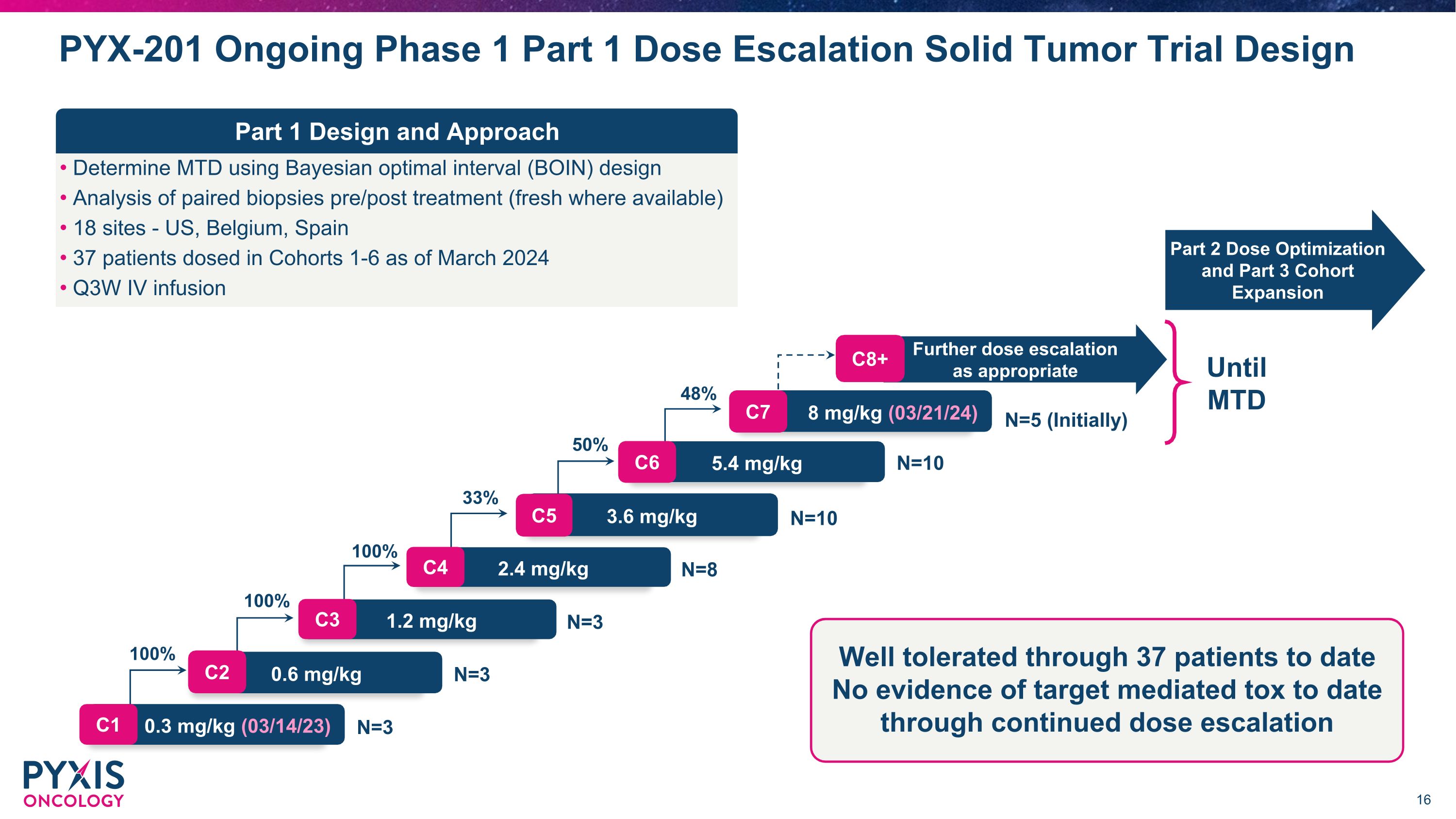
Determine MTD using Bayesian optimal interval (BOIN) design Analysis of paired biopsies pre/post treatment (fresh where available) 18 sites - US, Belgium, Spain 37 patients dosed in Cohorts 1-6 as of March 2024 Q3W IV infusion PYX-201 Ongoing Phase 1 Part 1 Dose Escalation Solid Tumor Trial Design Further dose escalation as appropriate 0.3 mg/kg (03/14/23) N=3 0.6 mg/kg N=3 1.2 mg/kg N=3 2.4 mg/kg N=8 3.6 mg/kg N=10 5.4 mg/kg N=10 8 mg/kg (03/21/24) N=5 (Initially) 100% 100% 100% 33% 50% 48% C1 C2 C3 C4 C5 C6 C7 C8+ Part 2 Dose Optimization and Part 3 Cohort Expansion Until MTD Well tolerated through 37 patients to date �No evidence of target mediated tox to date through continued dose escalation Part 1 Design and Approach
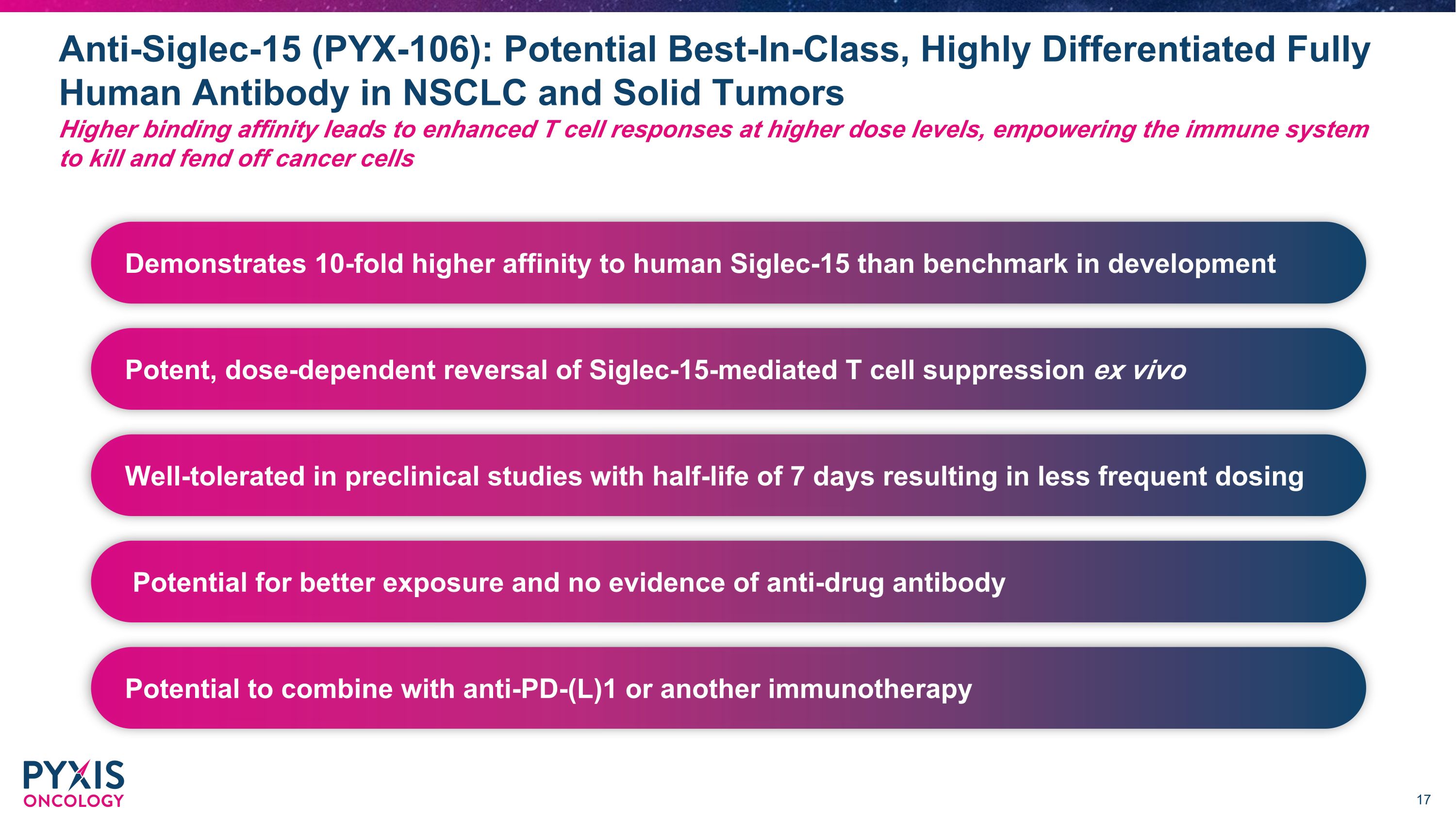
Anti-Siglec-15 (PYX-106): Potential Best-In-Class, Highly Differentiated Fully Human Antibody in NSCLC and Solid Tumors Higher binding affinity leads to enhanced T cell responses at higher dose levels, empowering the immune system to kill and fend off cancer cells Potential to combine with anti-PD-(L)1 or another immunotherapy Potential for better exposure and no evidence of anti-drug antibody Well-tolerated in preclinical studies with half-life of 7 days resulting in less frequent dosing Demonstrates 10-fold higher affinity to human Siglec-15 than benchmark in development Potent, dose-dependent reversal of Siglec-15-mediated T cell suppression ex vivo
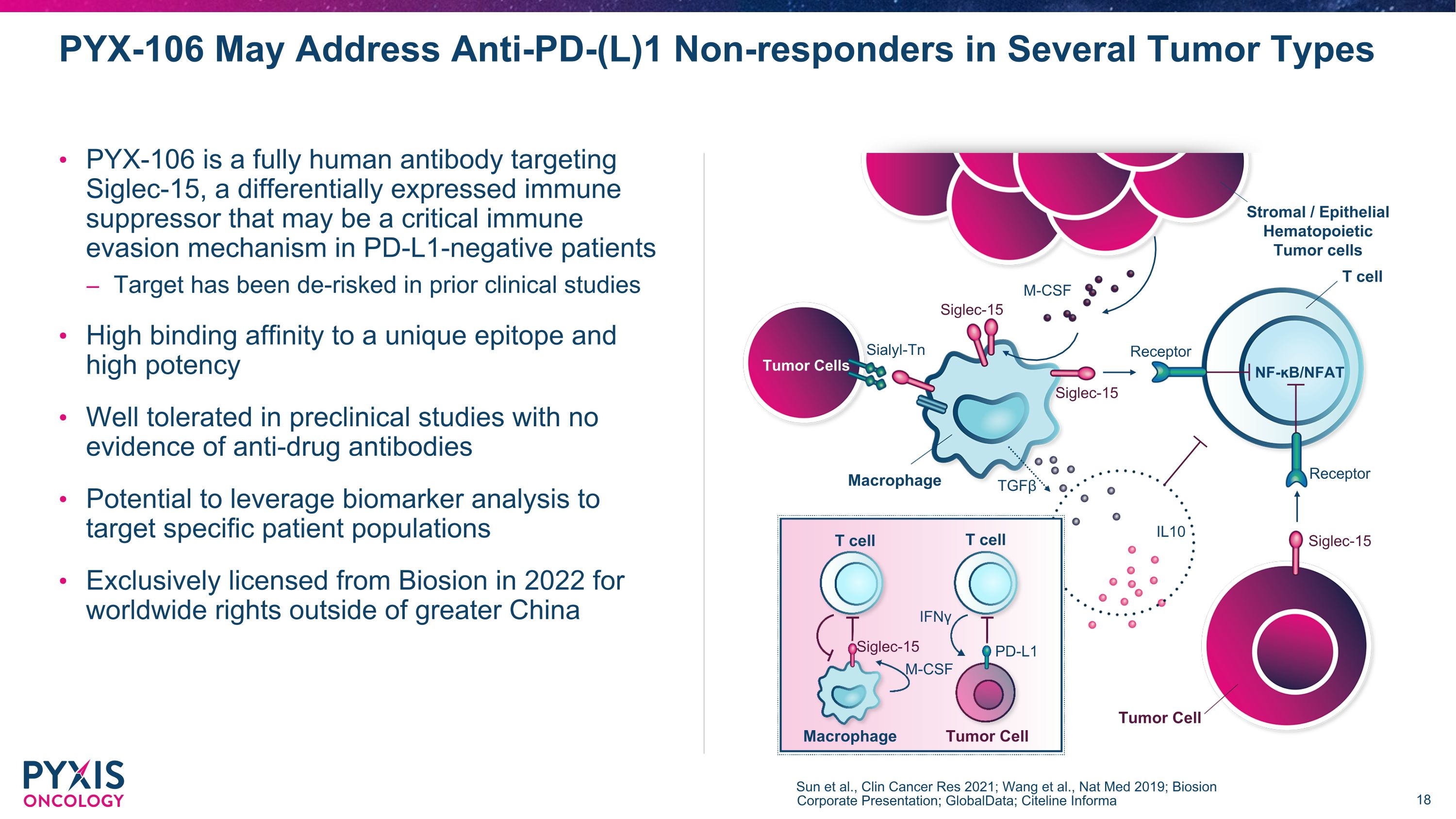
PYX-106 May Address Anti-PD-(L)1 Non-responders in Several Tumor Types Sun et al., Clin Cancer Res 2021; Wang et al., Nat Med 2019; Biosion Corporate Presentation; GlobalData; Citeline Informa Stromal / Epithelial Hematopoietic Tumor cells T cell NF-ĸB/NFAT Tumor Cells Macrophage Tumor Cell Receptor Receptor TGFβ Sialyl-Tn M-CSF Siglec-15 Siglec-15 Siglec-15 IL10 Siglec-15 M-CSF PD-L1 IFNγ T cell T cell Macrophage Tumor Cell PYX-106 is a fully human antibody targeting Siglec-15, a differentially expressed immune suppressor that may be a critical immune evasion mechanism in PD-L1-negative patients Target has been de-risked in prior clinical studies High binding affinity to a unique epitope and high potency Well tolerated in preclinical studies with no evidence of anti-drug antibodies Potential to leverage biomarker analysis to target specific patient populations Exclusively licensed from Biosion in 2022 for worldwide rights outside of greater China
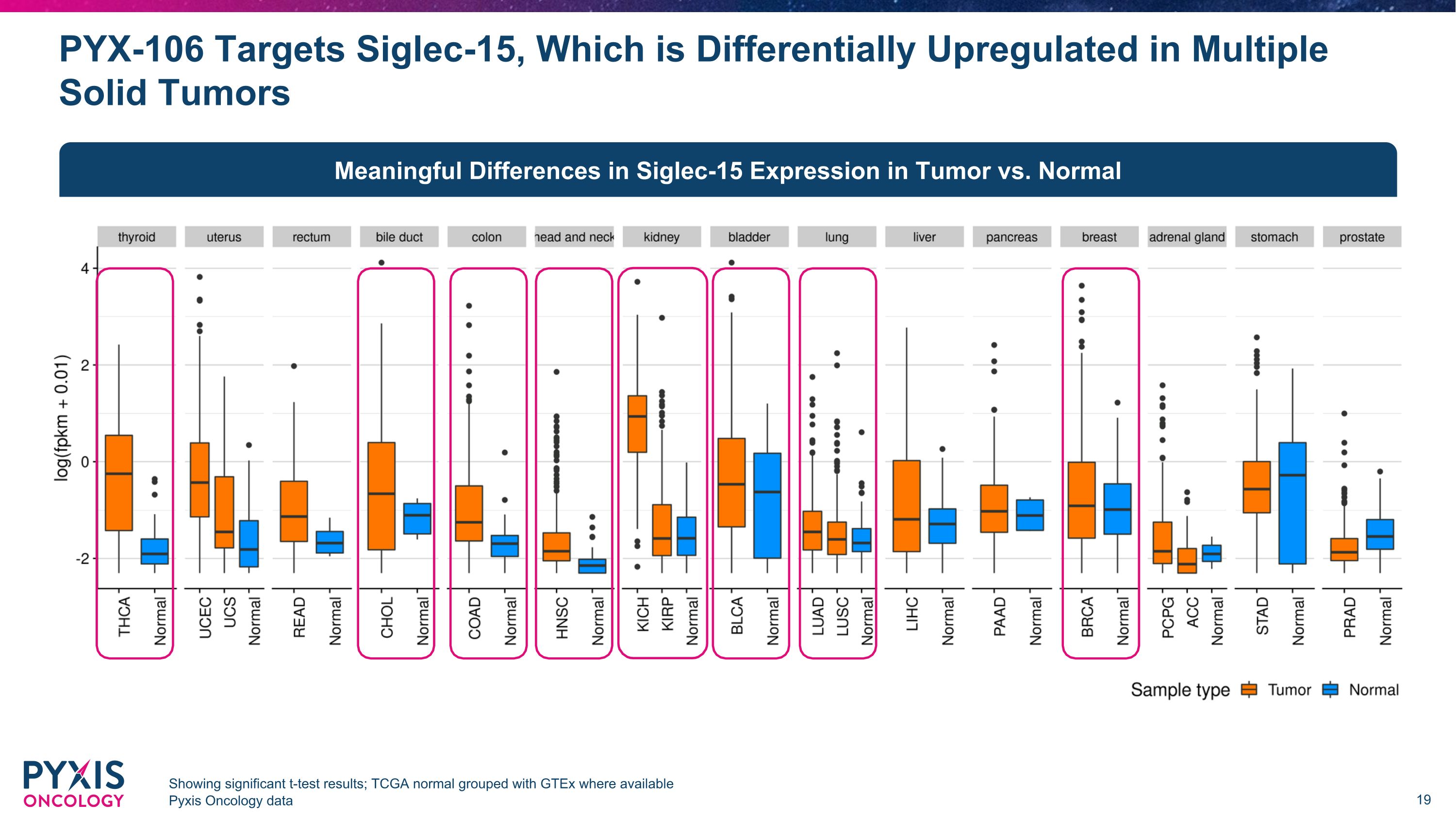
PYX-106 Targets Siglec-15, Which is Differentially Upregulated in Multiple Solid Tumors Showing significant t-test results; TCGA normal grouped with GTEx where available Pyxis Oncology data Meaningful Differences in Siglec-15 Expression in Tumor vs. Normal
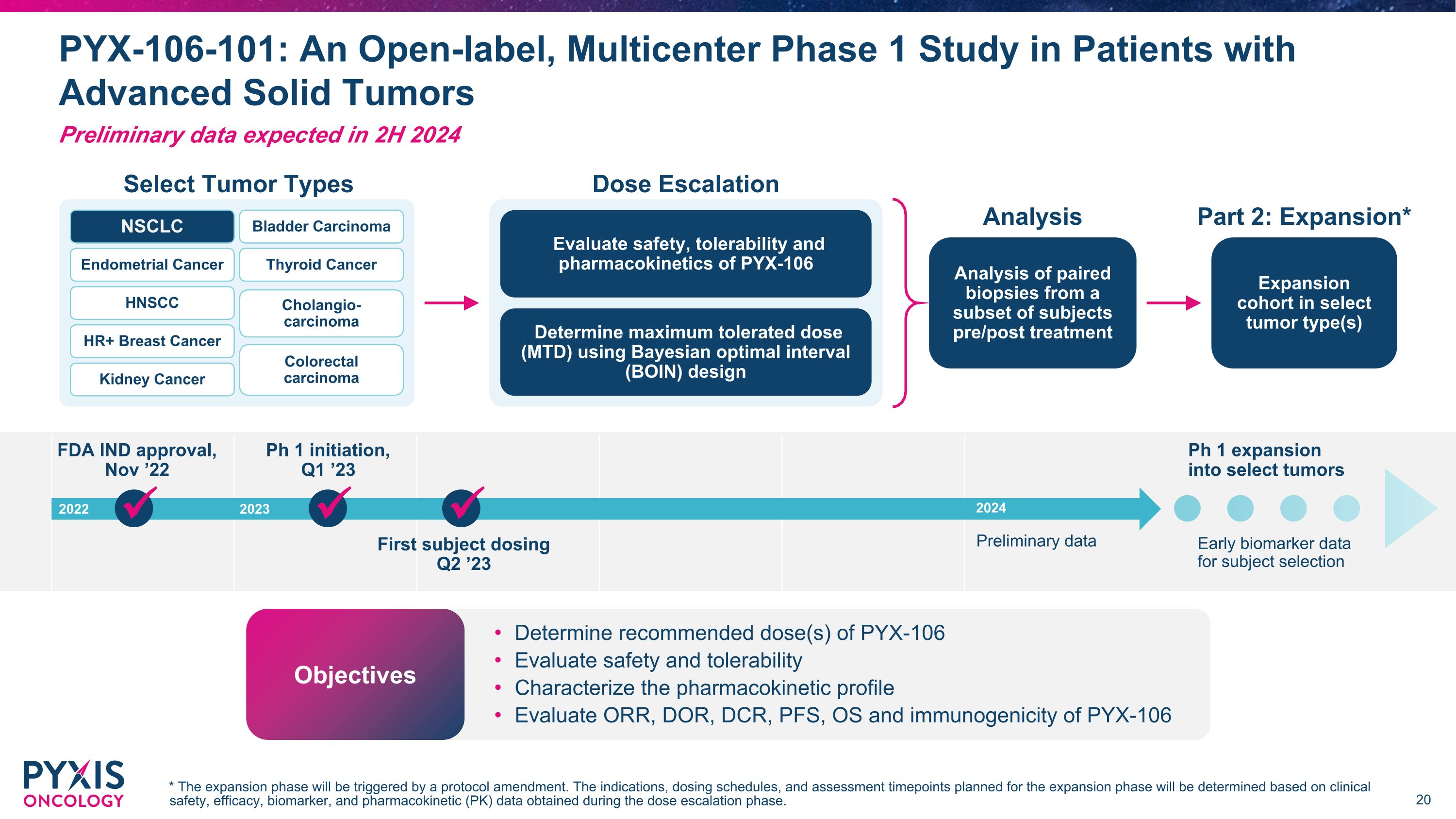
FDA IND approval, Nov ’22 Ph 1 initiation, �Q1 ’23 Ph 1 expansion into select tumors Early biomarker data for subject selection First subject dosing �Q2 ’23 2022 2023 2024 Preliminary data Select Tumor Types Dose Escalation Analysis Expansion cohort in select tumor type(s) Analysis of paired biopsies from a subset of subjects pre/post treatment Determine maximum tolerated dose (MTD) using Bayesian optimal interval (BOIN) design Evaluate safety, tolerability and pharmacokinetics of PYX-106 Endometrial Cancer HNSCC HR+ Breast Cancer Kidney Cancer Thyroid Cancer Cholangio-carcinoma Colorectal carcinoma NSCLC Bladder Carcinoma Part 2: Expansion* Determine recommended dose(s) of PYX-106 Evaluate safety and tolerability Characterize the pharmacokinetic profile Evaluate ORR, DOR, DCR, PFS, OS and immunogenicity of PYX-106 Objectives PYX-106-101: An Open-label, Multicenter Phase 1 Study in Patients with Advanced Solid Tumors * The expansion phase will be triggered by a protocol amendment. The indications, dosing schedules, and assessment timepoints planned for the expansion phase will be determined based on clinical safety, efficacy, biomarker, and pharmacokinetic (PK) data obtained during the dose escalation phase. Preliminary data expected in 2H 2024
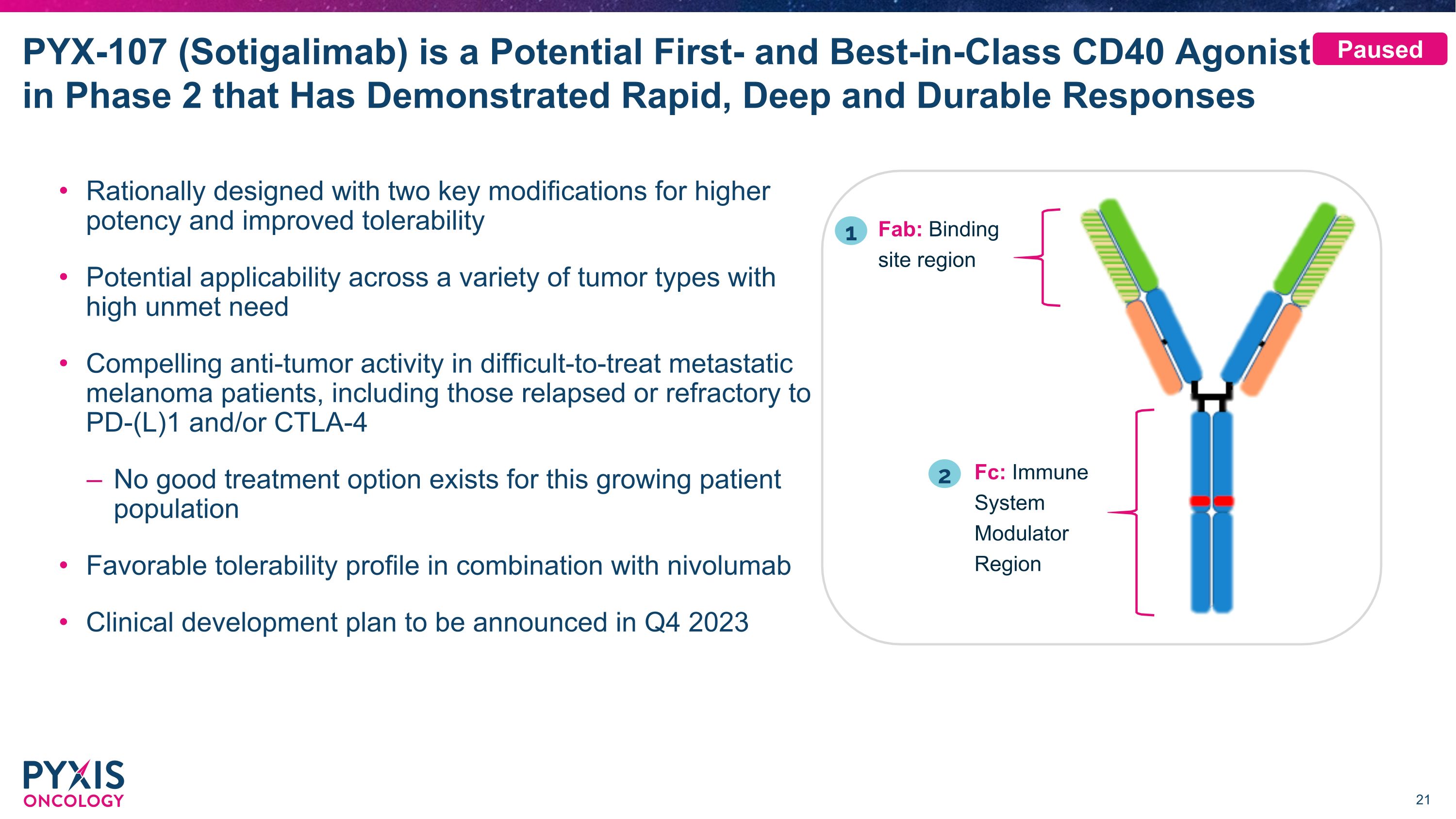
PYX-107 (Sotigalimab) is a Potential First- and Best-in-Class CD40 Agonist in Phase 2 that Has Demonstrated Rapid, Deep and Durable Responses Rationally designed with two key modifications for higher potency and improved tolerability Potential applicability across a variety of tumor types with high unmet need Compelling anti-tumor activity in difficult-to-treat metastatic melanoma patients, including those relapsed or refractory to PD-(L)1 and/or CTLA-4 No good treatment option exists for this growing patient population Favorable tolerability profile in combination with nivolumab Clinical development plan to be announced in Q4 2023 Fab: Binding site region Fc: Immune System Modulator Region 1 2 Paused
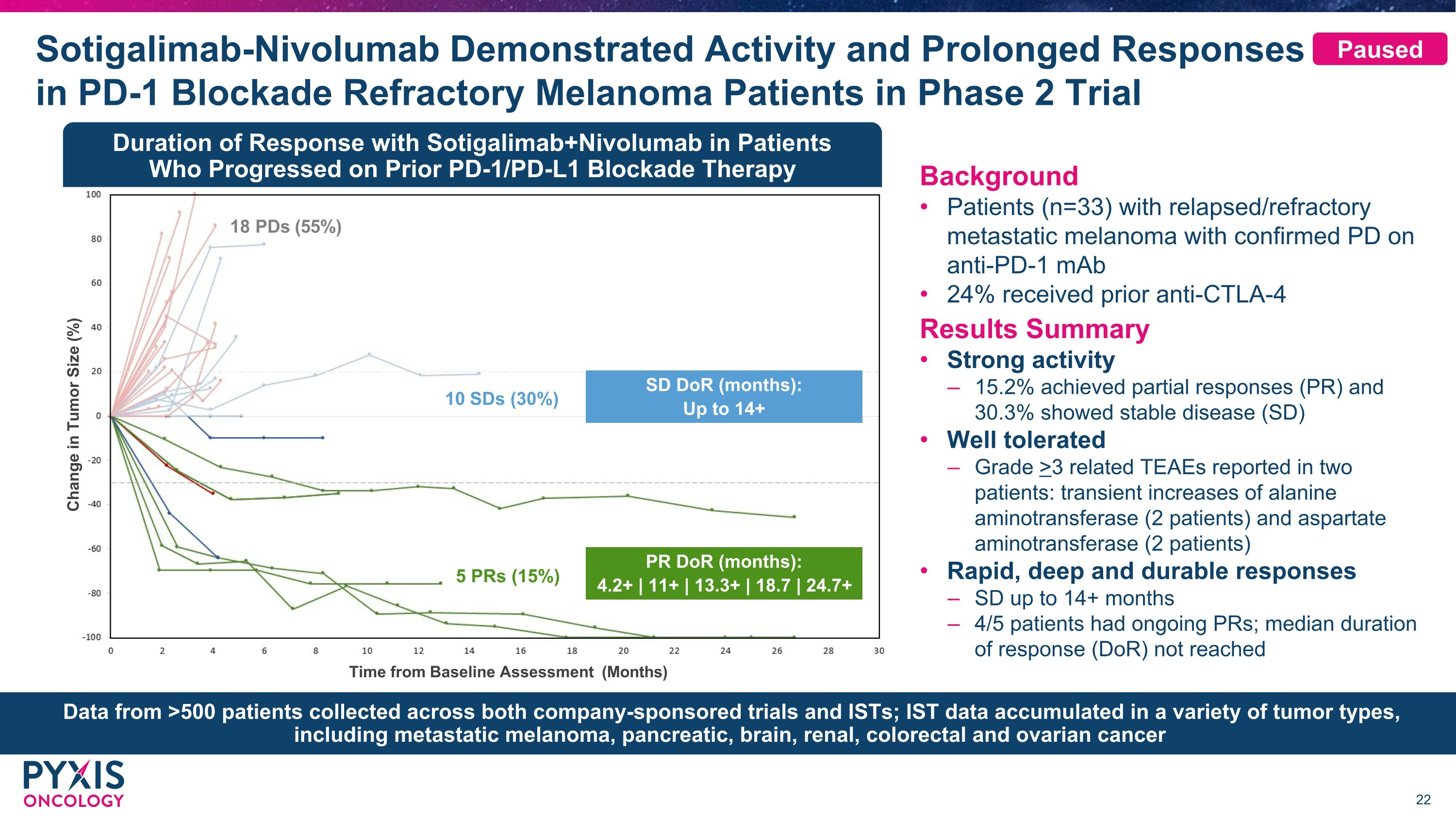
Sotigalimab-Nivolumab Demonstrated Activity and Prolonged Responses �in PD-1 Blockade Refractory Melanoma Patients in Phase 2 Trial Change in Tumor Size (%) Time from Baseline Assessment (Months) 5 PRs (15%) PR DoR (months): 4.2+ | 11+ | 13.3+ | 18.7 | 24.7+ SD DoR (months): Up to 14+ 10 SDs (30%) 18 PDs (55%) Background Patients (n=33) with relapsed/refractory metastatic melanoma with confirmed PD on anti-PD-1 mAb 24% received prior anti-CTLA-4 Results Summary Strong activity 15.2% achieved partial responses (PR) and 30.3% showed stable disease (SD) Well tolerated Grade >3 related TEAEs reported in two patients: transient increases of alanine aminotransferase (2 patients) and aspartate aminotransferase (2 patients) Rapid, deep and durable responses SD up to 14+ months 4/5 patients had ongoing PRs; median duration of response (DoR) not reached Duration of Response with Sotigalimab+Nivolumab in Patients �Who Progressed on Prior PD-1/PD-L1 Blockade Therapy Data from >500 patients collected across both company-sponsored trials and ISTs; IST data accumulated in a variety of tumor types, including metastatic melanoma, pancreatic, brain, renal, colorectal and ovarian cancer Paused
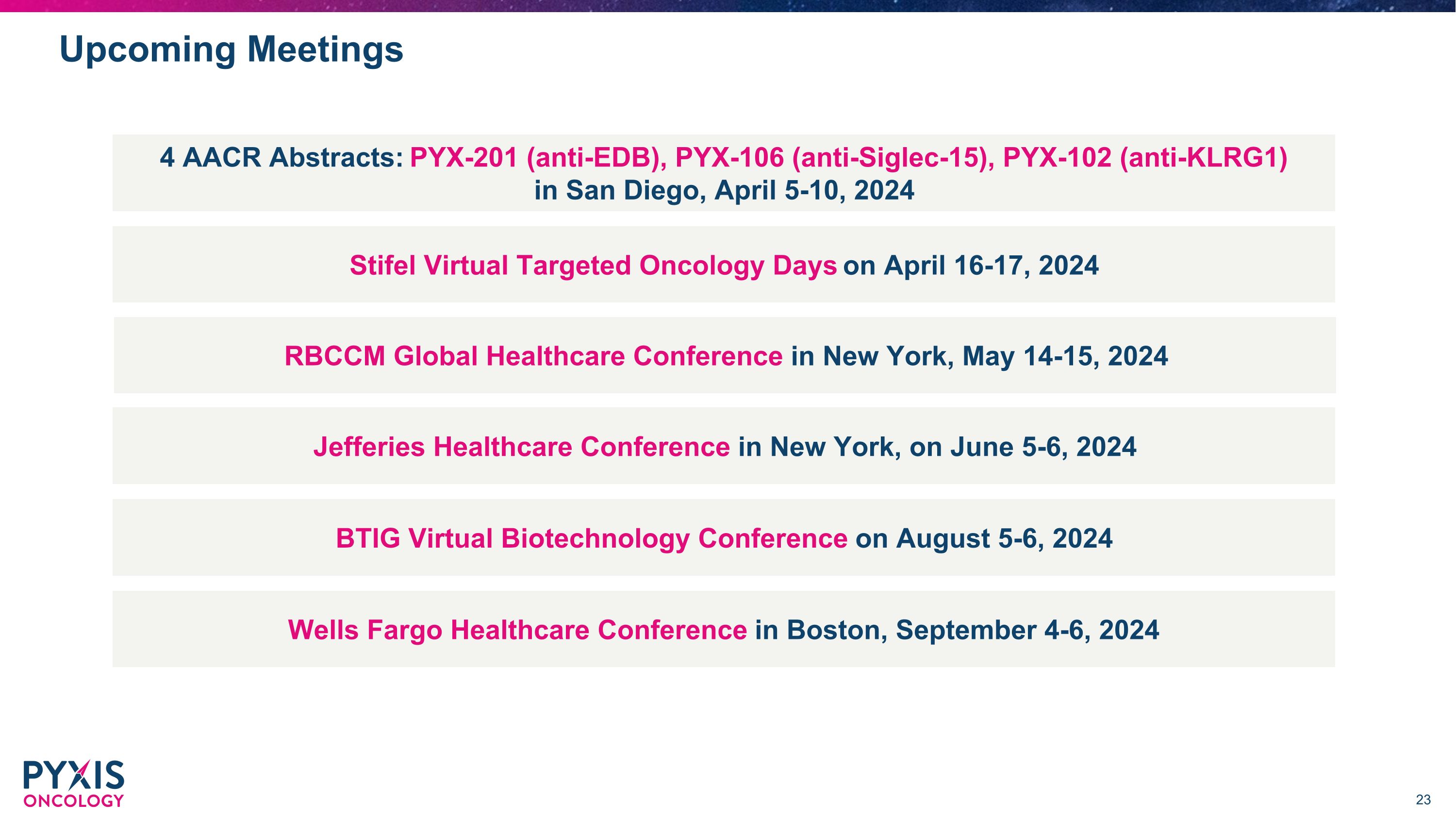
Upcoming Meetings RBCCM Global Healthcare Conference in New York, May 14-15, 2024 BTIG Virtual Biotechnology Conference on August 5-6, 2024 Wells Fargo Healthcare Conference in Boston, September 4-6, 2024 4 AACR Abstracts: PYX-201 (anti-EDB), PYX-106 (anti-Siglec-15), PYX-102 (anti-KLRG1) in San Diego, April 5-10, 2024 Stifel Virtual Targeted Oncology Days on April 16-17, 2024 Jefferies Healthcare Conference in New York, on June 5-6, 2024
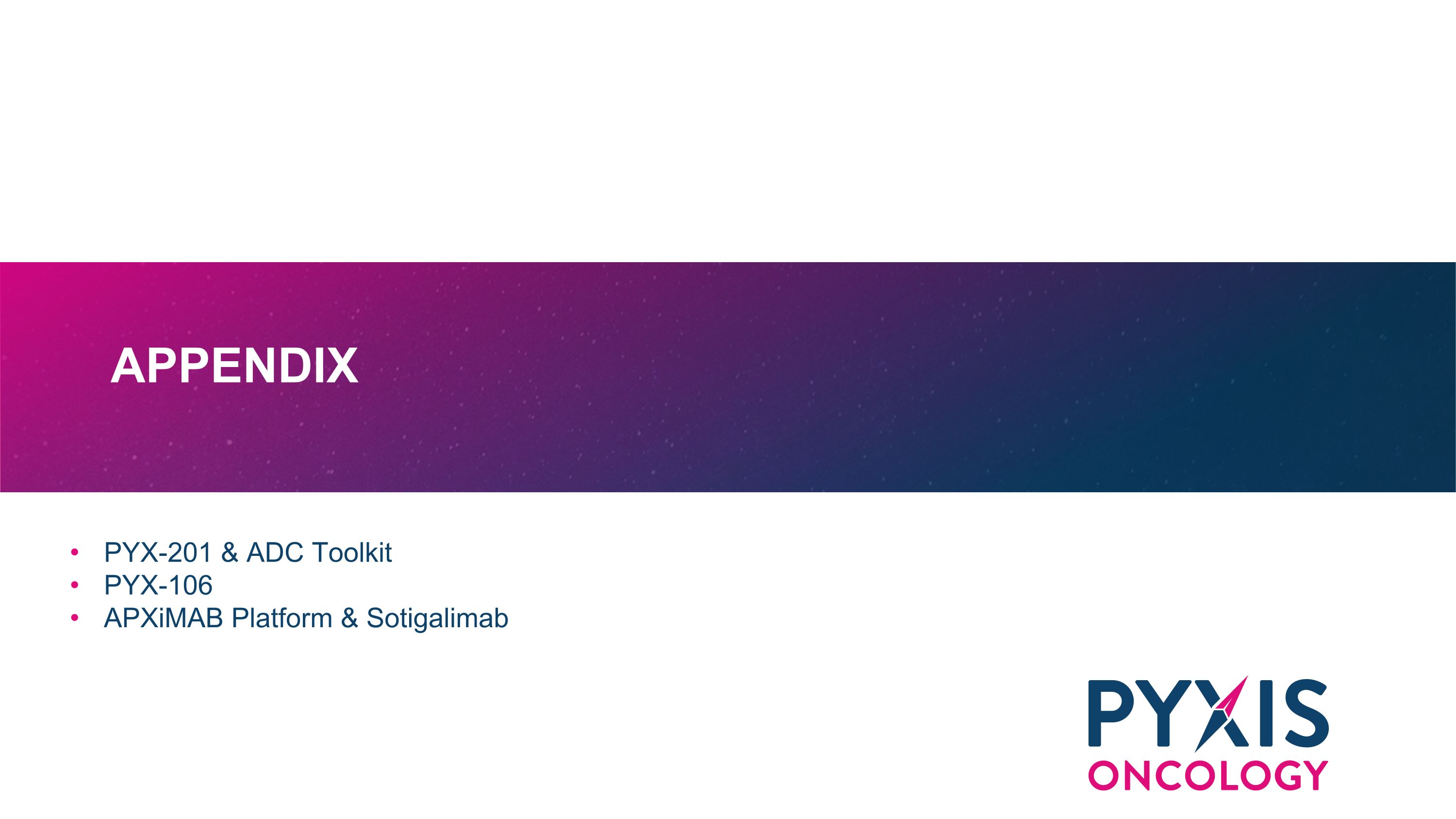
APPENDIX PYX-201 & ADC Toolkit PYX-106 APXiMAB Platform & Sotigalimab
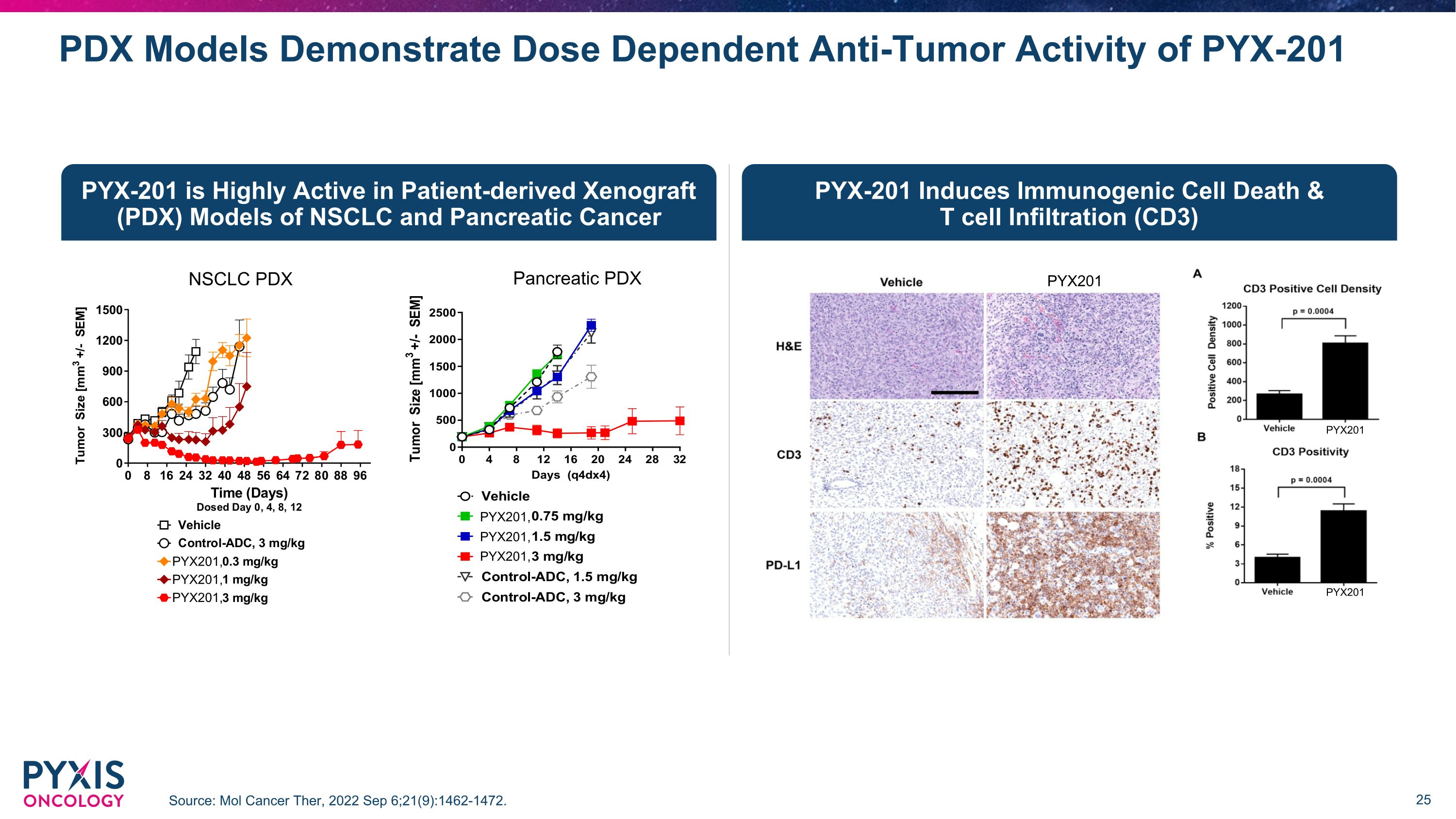
PYX-201 is Highly Active in Patient-derived Xenograft (PDX) Models of NSCLC and Pancreatic Cancer PYX-201 Induces Immunogenic Cell Death & �T cell Infiltration (CD3) PDX Models Demonstrate Dose Dependent Anti-Tumor Activity of PYX-201 Source: Mol Cancer Ther, 2022 Sep 6;21(9):1462-1472. PYX201 PYX201 PYX201 PYX201, PYX201, PYX201, Pancreatic PDX PYX201, PYX201, PYX201, NSCLC PDX
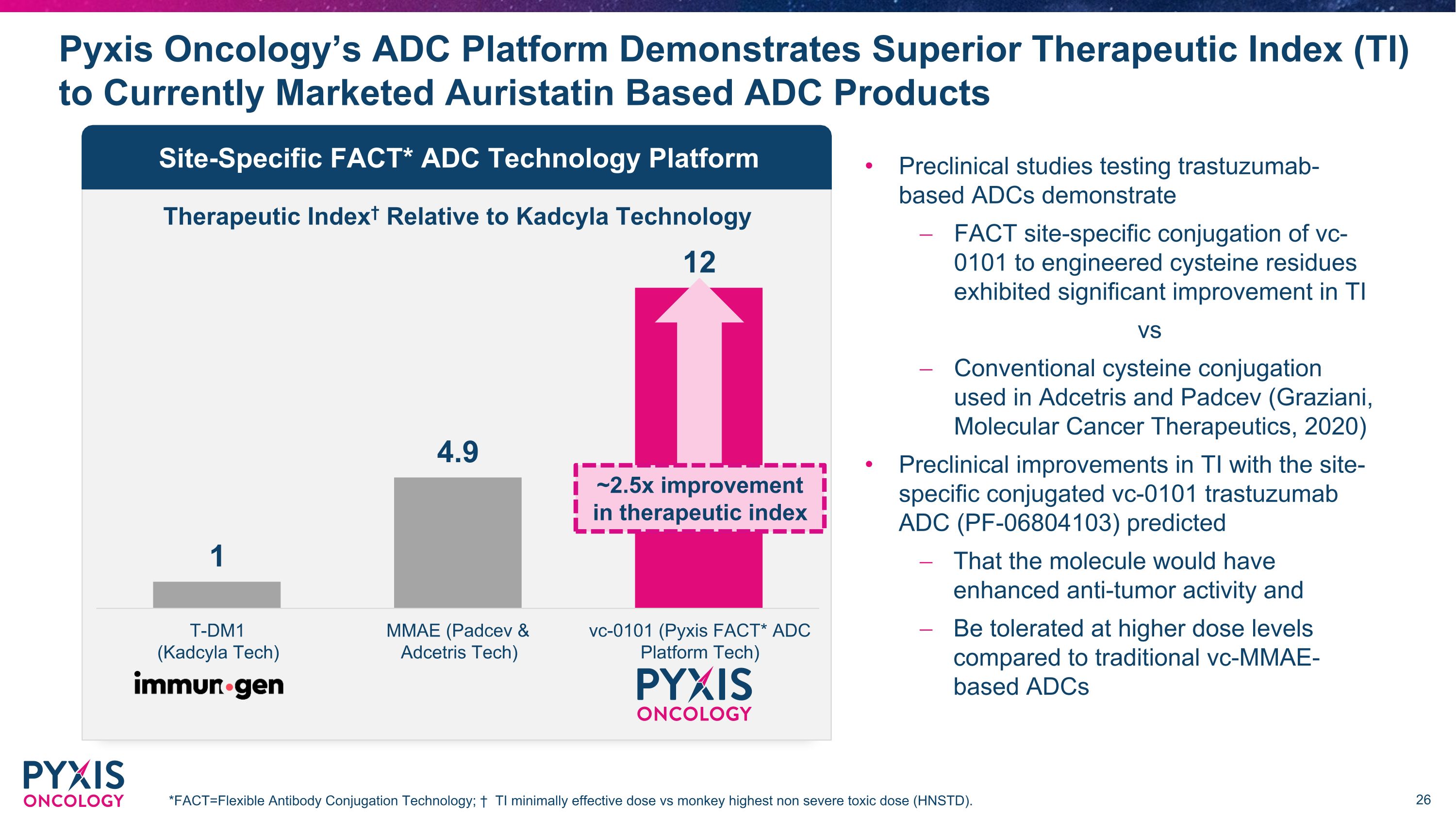
Therapeutic Index† Relative to Kadcyla Technology Pyxis Oncology’s ADC Platform Demonstrates Superior Therapeutic Index (TI) to Currently Marketed Auristatin Based ADC Products *FACT=Flexible Antibody Conjugation Technology; † TI minimally effective dose vs monkey highest non severe toxic dose (HNSTD). Site-Specific FACT* ADC Technology Platform ~2.5x improvement in therapeutic index Preclinical studies testing trastuzumab-based ADCs demonstrate FACT site-specific conjugation of vc-0101 to engineered cysteine residues exhibited significant improvement in TI vs Conventional cysteine conjugation used in Adcetris and Padcev (Graziani, Molecular Cancer Therapeutics, 2020) Preclinical improvements in TI with the site-specific conjugated vc-0101 trastuzumab ADC (PF-06804103) predicted That the molecule would have enhanced anti-tumor activity and Be tolerated at higher dose levels compared to traditional vc-MMAE-based ADCs
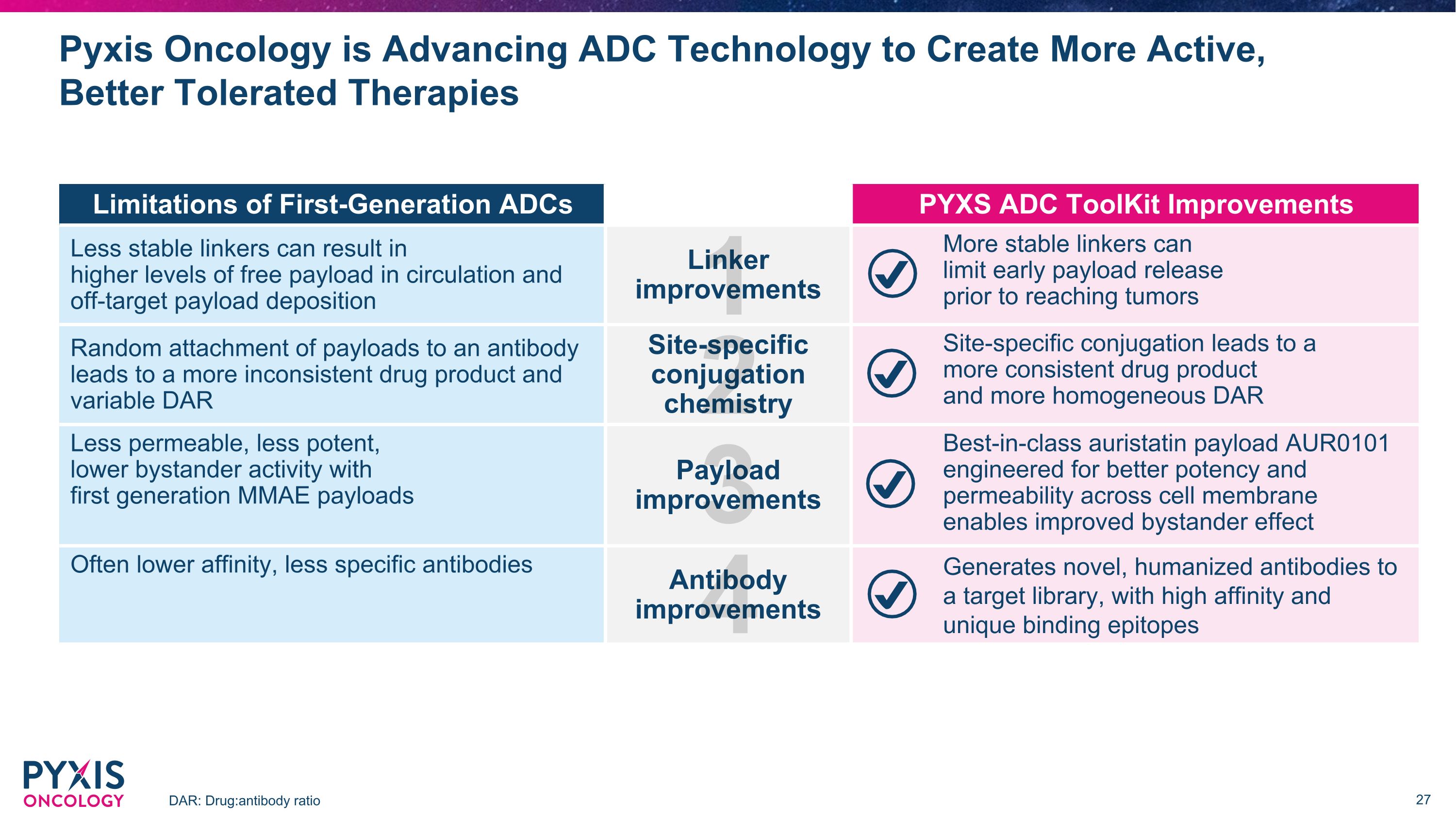
Pyxis Oncology is Advancing ADC Technology to Create More Active, �Better Tolerated Therapies DAR: Drug:antibody ratio Limitations of First-Generation ADCs PYXS ADC ToolKit Improvements Less stable linkers can result in �higher levels of free payload in circulation and off-target payload deposition Linker improvements More stable linkers can �limit early payload release �prior to reaching tumors Random attachment of payloads to an antibody leads to a more inconsistent drug product and variable DAR Site-specific conjugation chemistry Site-specific conjugation leads to a �more consistent drug product �and more homogeneous DAR Less permeable, less potent, �lower bystander activity with �first generation MMAE payloads Payload improvements Best-in-class auristatin payload AUR0101 engineered for better potency and permeability across cell membrane enables improved bystander effect Often lower affinity, less specific antibodies Antibody improvements Generates novel, humanized antibodies to a target library, with high affinity and unique binding epitopes 1 2 3 4
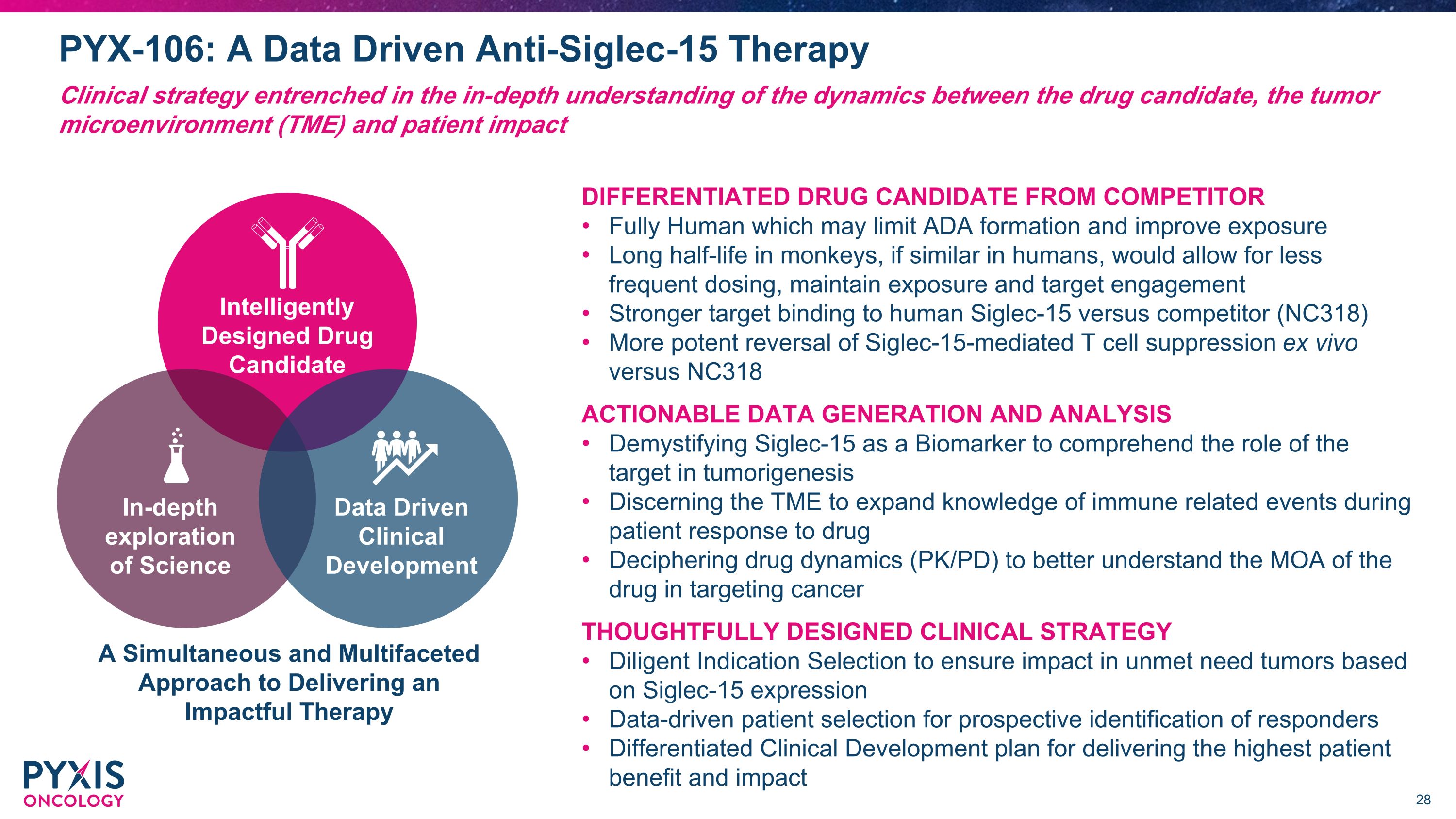
PYX-106: A Data Driven Anti-Siglec-15 Therapy Clinical strategy entrenched in the in-depth understanding of the dynamics between the drug candidate, the tumor microenvironment (TME) and patient impact DIFFERENTIATED DRUG CANDIDATE FROM COMPETITOR Fully Human which may limit ADA formation and improve exposure Long half-life in monkeys, if similar in humans, would allow for less frequent dosing, maintain exposure and target engagement Stronger target binding to human Siglec-15 versus competitor (NC318) More potent reversal of Siglec-15-mediated T cell suppression ex vivo versus NC318 ACTIONABLE DATA GENERATION AND ANALYSIS Demystifying Siglec-15 as a Biomarker to comprehend the role of the target in tumorigenesis Discerning the TME to expand knowledge of immune related events during patient response to drug Deciphering drug dynamics (PK/PD) to better understand the MOA of the drug in targeting cancer THOUGHTFULLY DESIGNED CLINICAL STRATEGY Diligent Indication Selection to ensure impact in unmet need tumors based on Siglec-15 expression Data-driven patient selection for prospective identification of responders Differentiated Clinical Development plan for delivering the highest patient benefit and impact A Simultaneous and Multifaceted Approach to Delivering an Impactful Therapy In-depth exploration of Science Data Driven Clinical Development Intelligently Designed Drug Candidate
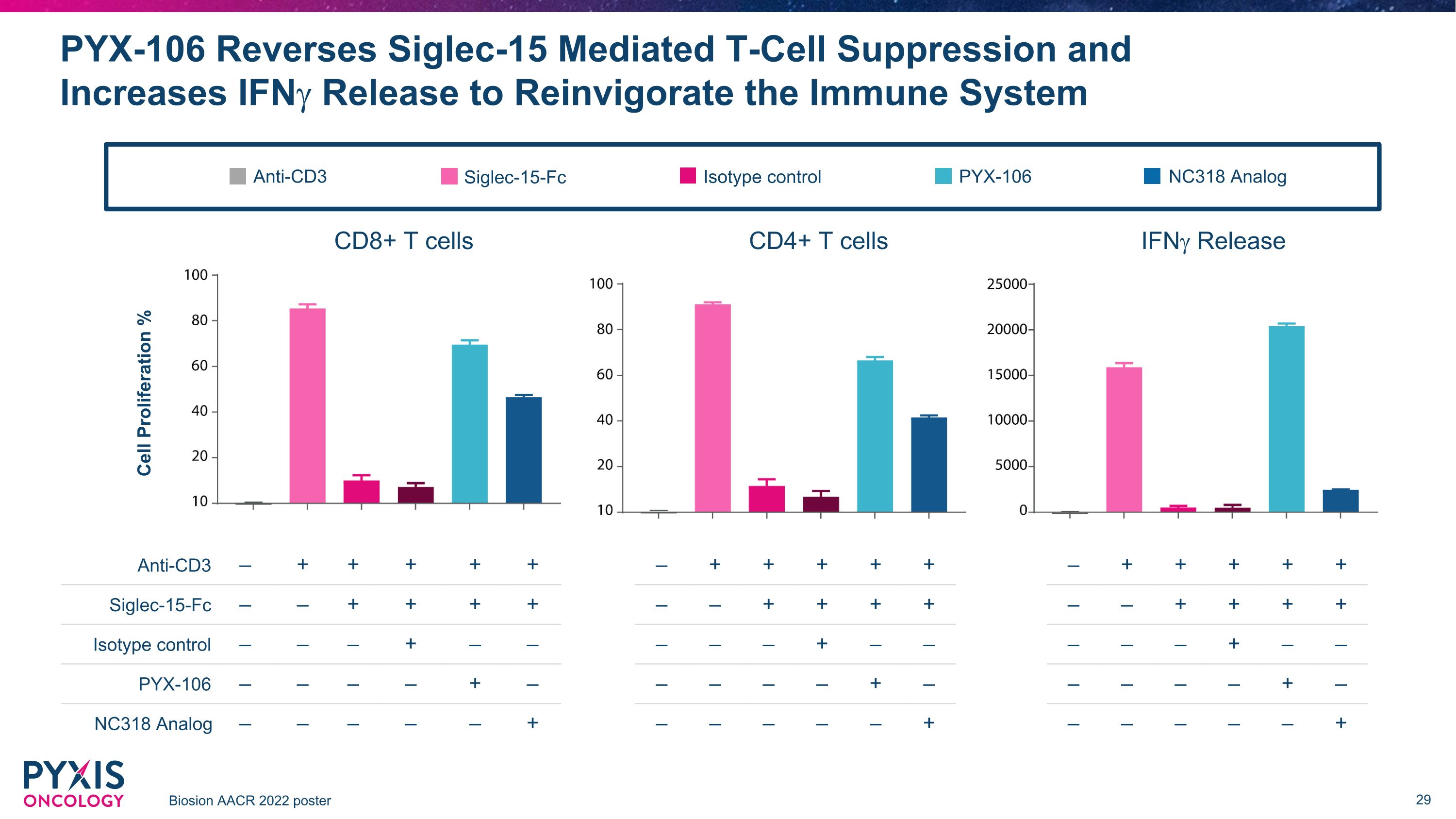
PYX-106 Reverses Siglec-15 Mediated T-Cell Suppression and�Increases IFNg Release to Reinvigorate the Immune System Biosion AACR 2022 poster CD8+ T cells CD4+ T cells IFNg Release Anti-CD3 – + + + + + Siglec-15-Fc – – + + + + Isotype control – – – + – – PYX-106 – – – – + – NC318 Analog – – – – – + Cell Proliferation % – + + + + + – – + + + + – – – + – – – – – – + – – – – – – + – + + + + + – – + + + + – – – + – – – – – – + – – – – – – + Anti-CD3 Siglec-15-Fc Isotype control PYX-106 NC318 Analog
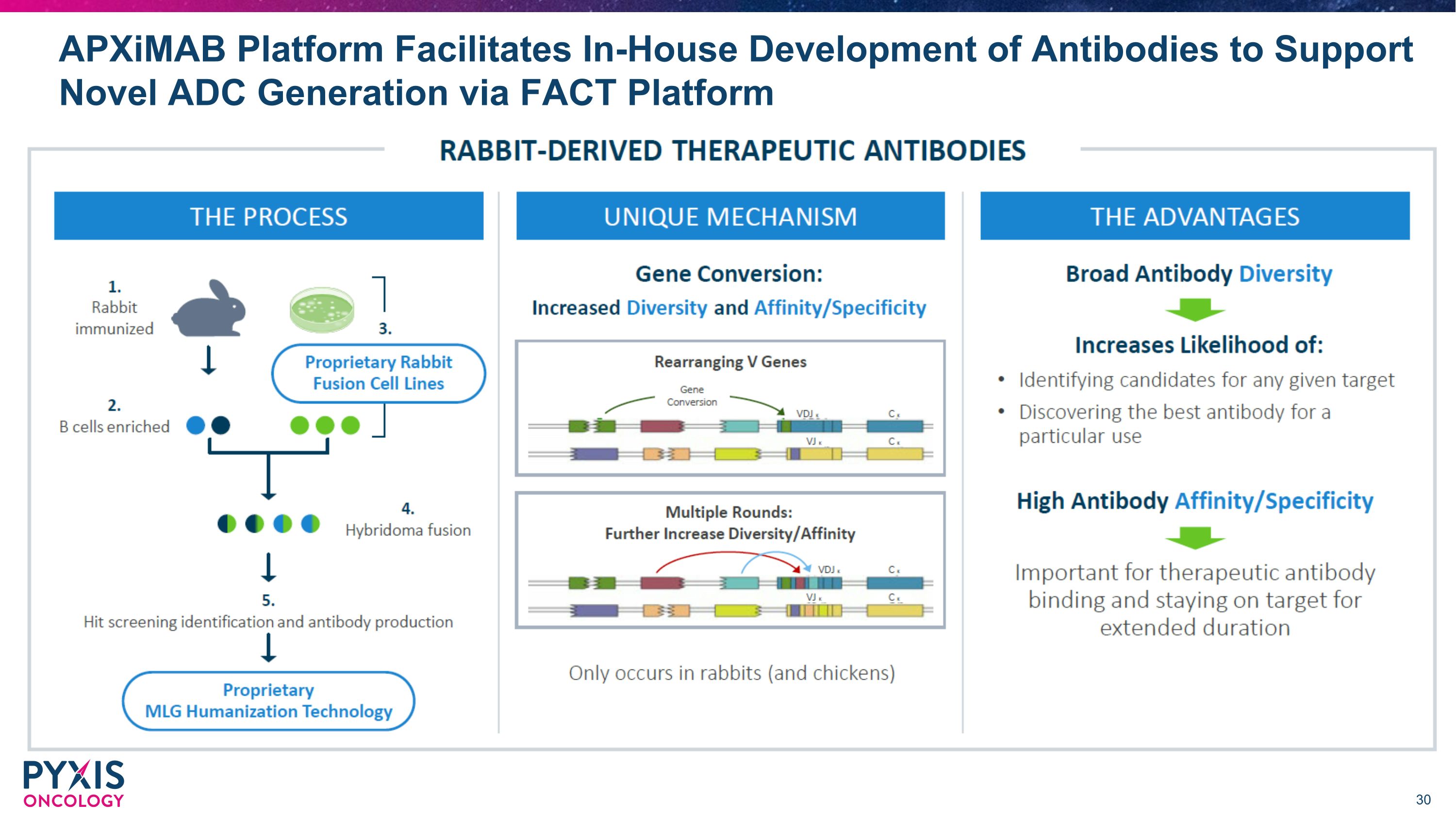
APXiMAB Platform Facilitates In-House Development of Antibodies to Support Novel ADC Generation via FACT Platform
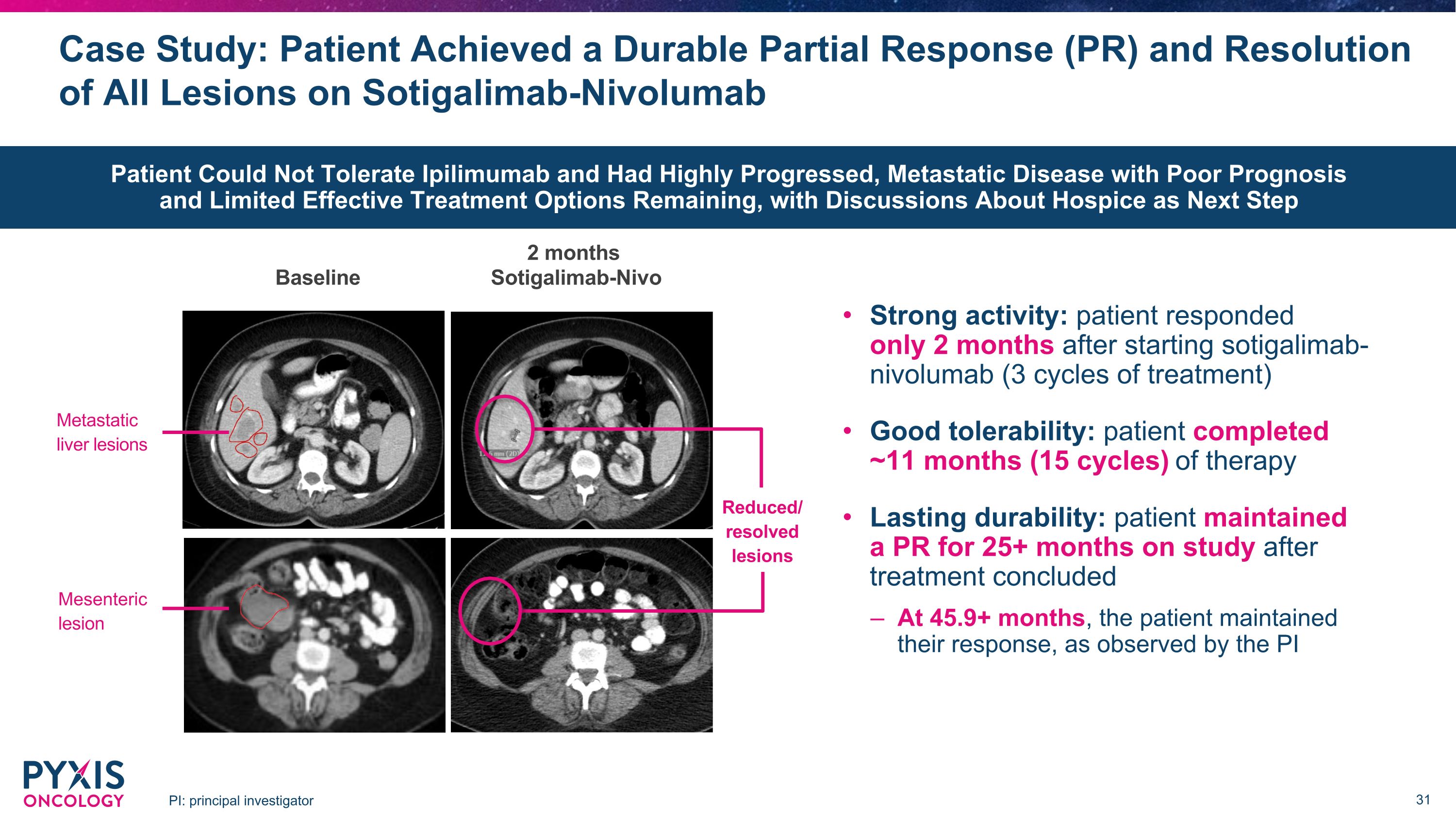
Case Study: Patient Achieved a Durable Partial Response (PR) and Resolution of All Lesions on Sotigalimab-Nivolumab PI: principal investigator 2 months Baseline Sotigalimab-Nivo Strong activity: patient responded �only 2 months after starting sotigalimab-nivolumab (3 cycles of treatment) Good tolerability: patient completed �~11 months (15 cycles) of therapy Lasting durability: patient maintained �a PR for 25+ months on study after treatment concluded At 45.9+ months, the patient maintained their response, as observed by the PI Reduced/ resolved lesions Metastatic liver lesions Mesenteric lesion Patient Could Not Tolerate Ipilimumab and Had Highly Progressed, Metastatic Disease with Poor Prognosis �and Limited Effective Treatment Options Remaining, with Discussions About Hospice as Next Step
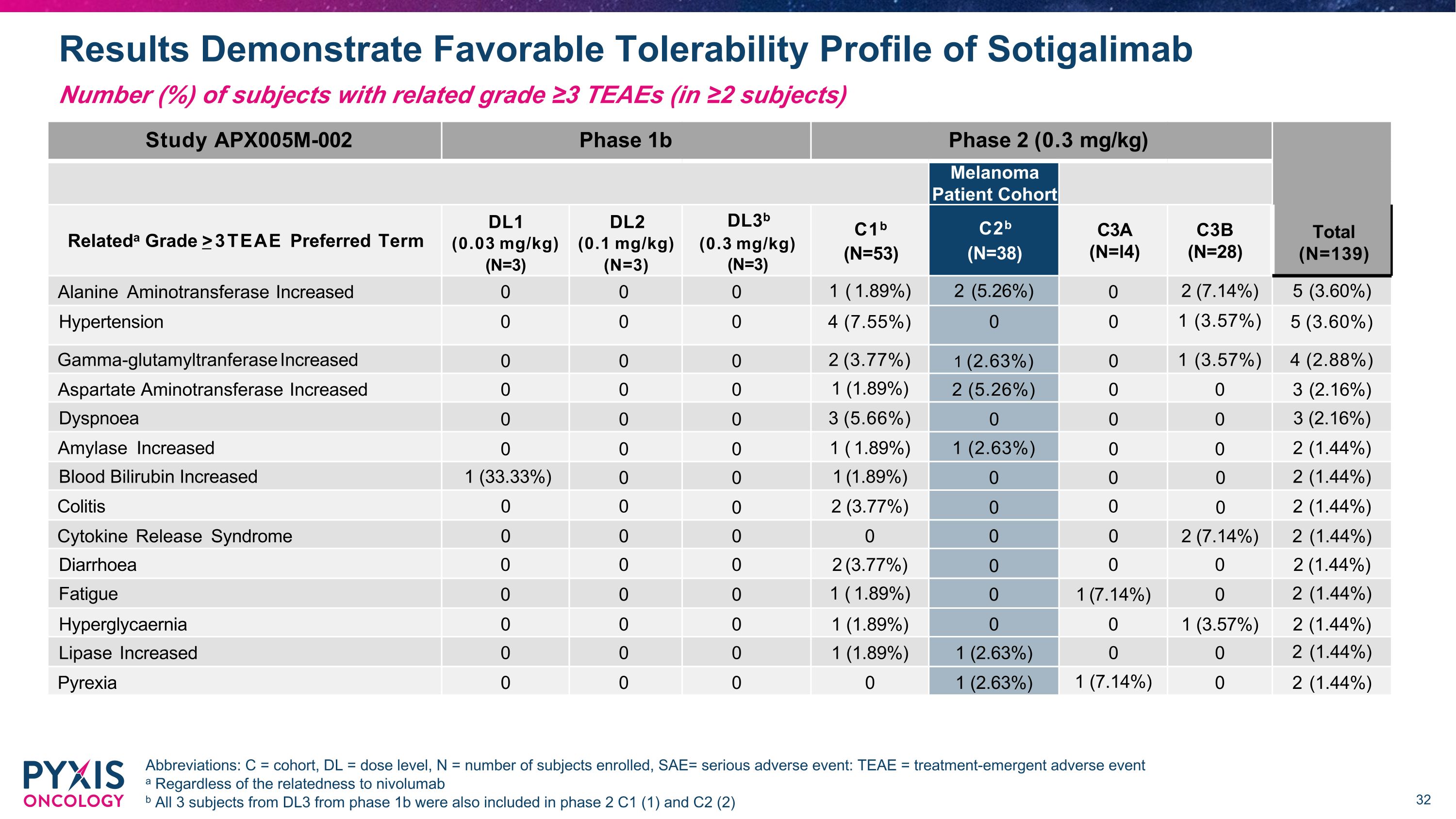
Results Demonstrate Favorable Tolerability Profile of Sotigalimab Abbreviations: C = cohort, DL = dose level, N = number of subjects enrolled, SAE= serious adverse event: TEAE = treatment-emergent adverse event a Regardless of the relatedness to nivolumab b All 3 subjects from DL3 from phase 1b were also included in phase 2 C1 (1) and C2 (2) Number (%) of subjects with related grade ≥3 TEAEs (in ≥2 subjects) Study APX005M-002 Phase 1b Phase 2 (0.3 mg/kg) Total (N=139) Melanoma Patient Cohort Relateda Grade > 3 TEAE Preferred Term DL1 (0.03 mg/kg) (N=3) DL2 (0.1 mg/kg) (N=3) DL3b (0.3 mg/kg) (N=3) C1b (N=53) C2b (N=38) C3A (N=l4) C3B (N=28) Alanine Aminotransferase Increased 0 0 0 1 ( 1.89%) 2 (5.26%) 0 2 (7.14%) 5 (3.60%) Hypertension 0 0 0 4 (7.55%) 0 0 1 (3.57%) 5 (3.60%) Gamma-glutamyltranferase Increased 0 0 0 2 (3.77%) 1 (2.63%) 0 1 (3.57%) 4 (2.88%) Aspartate Aminotransferase Increased 0 0 0 1 (1.89%) 2 (5.26%) 0 0 3 (2.16%) Dyspnoea 0 0 0 3 (5.66%) 0 0 0 3 (2.16%) Amylase Increased 0 0 0 1 ( 1.89%) 1 (2.63%) 0 0 2 (1.44%) Blood Bilirubin Increased 1 (33.33%) 0 0 1 (1.89%) 0 0 0 2 (1.44%) Colitis 0 0 0 2 (3.77%) 0 0 0 2 (1.44%) Cytokine Release Syndrome 0 0 0 0 0 0 2 (7.14%) 2 (1.44%) Diarrhoea 0 0 0 2 (3.77%) 0 0 0 2 (1.44%) Fatigue 0 0 0 1 ( 1.89%) 0 1 (7.14%) 0 2 (1.44%) Hyperglycaernia 0 0 0 1 (1.89%) 0 0 1 (3.57%) 2 (1.44%) Lipase Increased 0 0 0 1 (1.89%) 1 (2.63%) 0 0 2 (1.44%) Pyrexia 0 0 0 0 1 (2.63%) 1 (7.14%) 0 2 (1.44%)
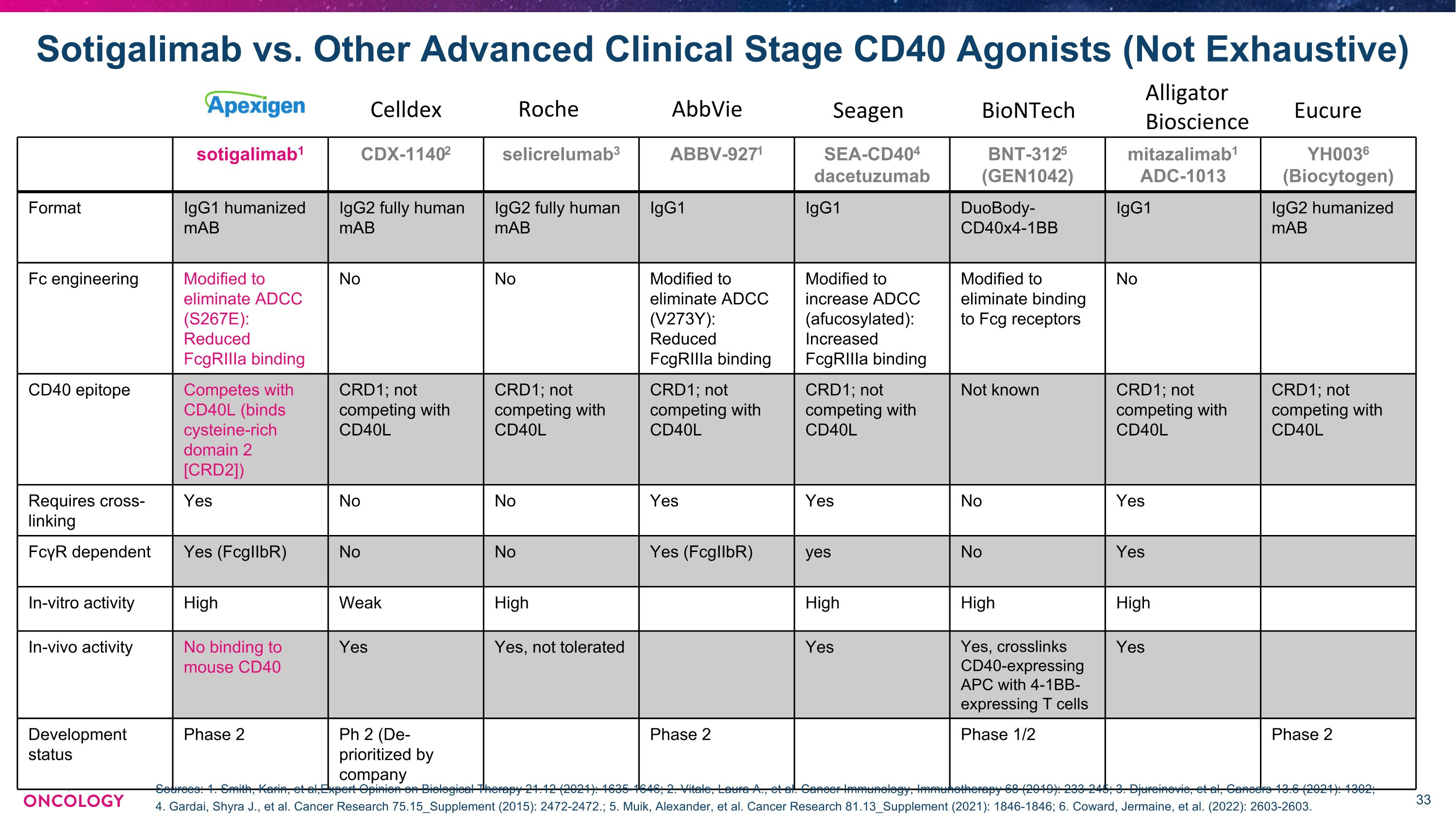
Sotigalimab vs. Other Advanced Clinical Stage CD40 Agonists (Not Exhaustive) sotigalimab1 CDX-11402 selicrelumab3 ABBV-9271 SEA-CD404 dacetuzumab BNT-3125 (GEN1042) mitazalimab1 ADC-1013 YH0036 (Biocytogen) Format IgG1 humanized mAB IgG2 fully human mAB IgG2 fully human mAB IgG1 IgG1 DuoBody-CD40x4-1BB IgG1 IgG2 humanized mAB Fc engineering Modified to eliminate ADCC (S267E): Reduced FcgRIIIa binding No No Modified to eliminate ADCC (V273Y): Reduced FcgRIIIa binding Modified to increase ADCC (afucosylated): Increased FcgRIIIa binding Modified to eliminate binding to Fcg receptors No CD40 epitope Competes with CD40L (binds cysteine-rich domain 2 [CRD2]) CRD1; not competing with CD40L CRD1; not competing with CD40L CRD1; not competing with CD40L CRD1; not competing with CD40L Not known CRD1; not competing with CD40L CRD1; not competing with CD40L Requires cross-linking Yes No No Yes Yes No Yes FcγR dependent Yes (FcgIIbR) No No Yes (FcgIIbR) yes No Yes In-vitro activity High Weak High High High High In-vivo activity No binding to mouse CD40 Yes Yes, not tolerated Yes Yes, crosslinks CD40-expressing APC with 4-1BB-expressing T cells Yes Development status Phase 2 Ph 2 (De-prioritized by company Phase 2 Phase 1/2 Phase 2 Celldex Roche AbbVie Seagen BioNTech Alligator Bioscience Eucure Sources: 1. Smith, Karin, et al,Expert Opinion on Biological Therapy 21.12 (2021): 1635-1646; 2. Vitale, Laura A., et al. Cancer Immunology, Immunotherapy 68 (2019): 233-245; 3. Djureinovic, et al, Cancers 13.6 (2021): 1302; 4. Gardai, Shyra J., et al. Cancer Research 75.15_Supplement (2015): 2472-2472.; 5. Muik, Alexander, et al. Cancer Research 81.13_Supplement (2021): 1846-1846; 6. Coward, Jermaine, et al. (2022): 2603-2603.
































